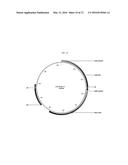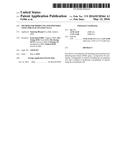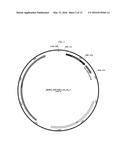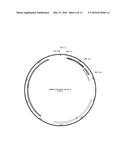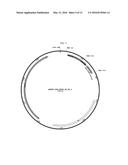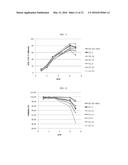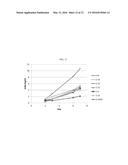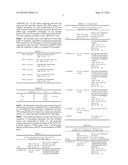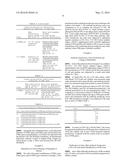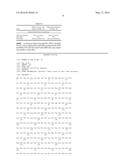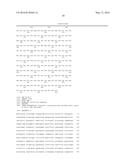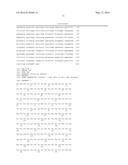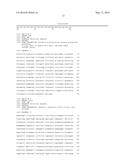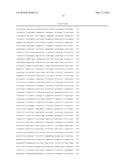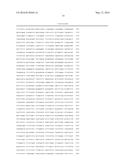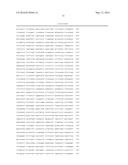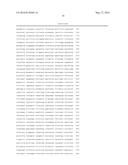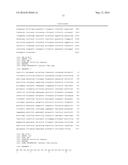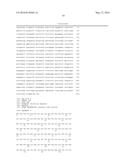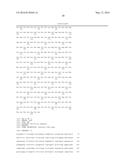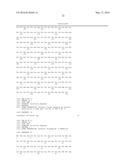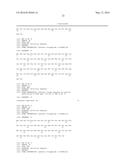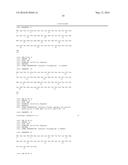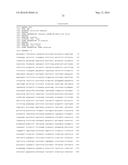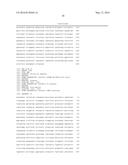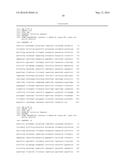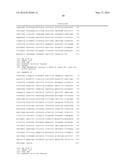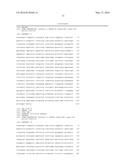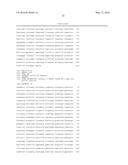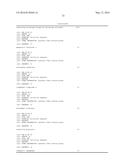Patent application title: METHOD FOR PRODUCING POLYPEPTIDES USING PDK-INACTIVATED CELLS
Inventors:
Eunyoung Park (Yongin-Si, KR)
Hye Young Suh (Seoul, KR)
Hee Kyung Sung (Suwon-Si, KR)
Christina Yi (Seongnam-Si, KR)
Sunkyu Kim (Suwon-Si, KR)
IPC8 Class: AC07K1640FI
USPC Class:
435 696
Class name: Micro-organism, tissue cell culture or enzyme using process to synthesize a desired chemical compound or composition recombinant dna technique included in method of making a protein or polypeptide blood proteins
Publication date: 2016-05-12
Patent application number: 20160130364
Abstract:
Provided is a recombinant cell including inactivated pyruvate
dehydrogenase kinase (PDK) gene, a composition for producing a
polypeptide of interest including the recombinant cell, and a method of
producing a polypeptide of interest using the recombinant cell.Claims:
1. A recombinant cell comprising an inactivated pyruvate dehydrogenase
kinase (PDK) gene.
2. The recombinant cell of claim 1, wherein the recombinant cell comprises: 1) a deletion of the entire PDK gene, 2) a deletion of 1 to 100 consecutive nucleotides of the PDK gene, or substitution of 1 to 100 consecutive nucleotides of the PDK gene, 3) an insertion of 1 to 100 nucleotides into PDK gene, 4) a PDK gene expression inhibitor, or 5) a combination thereof.
3. The recombinant cell of claim 1, wherein the recombinant cell comprises: a deletion of 1 to 50 consecutive nucleotides of the PDK gene; a substitution of 1 to 50 consecutive nucleotides of the PDK gene; an insertion of 1 to 50 nucleotides into the PDK gene; or a combination thereof.
4. The recombinant cell of claim 1, wherein the PDK gene is at least one selected from the group consisting of PDK1 gene, PDK2 gene, and PDK3 gene.
5. The recombinant cell of claim 1, comprising: an inactivated PDK1 gene in which 1 to 20 nucleotides selected from a region of 23-50 bp comprising the nucleotide sequence from the 235.sup.th to 241.sup.st positions of SEQ ID NO: 6 are deleted or substituted with a different nucleotide, an inactivated PDK2 gene in which 1 to 20 nucleotides selected from a region of 23-50 bp comprising the nucleotide sequence from the 172.sup.nd to 194.sup.th positions of SEQ ID NO: 8 are deleted or substituted with a different nucleotide, and/or 1 to 20 nucleotides are inserted within the region of 23-50 bp comprising the nucleotide sequence from the 172.sup.nd to 194.sup.th positions of SEQ ID NO: 8, an inactivated PDK3 gene in which 1 to 20 nucleotides are inserted within the region of 23-50 bp comprising the nucleotide sequence from the 38.sup.th to 60.sup.th positions of SEQ ID NO: 10, or a combination thereof.
6. The recombinant cell of claim 5, comprising: an inactivated PDK1 gene in which 1 to 7 nucleotides from the 235.sup.th to 241.sup.st positions of SEQ ID NO: 6 are deleted or substituted with a different nucleotide, an inactivated PDK2 gene in which 1 to 20 nucleotides from the 172.sup.nd to 194.sup.th positions of SEQ ID NO: 8 are deleted or substituted with a different nucleotide, and/or 1 to 20 nucleotides are inserted within the region from the 172.sup.nd to 194.sup.th positions of SEQ ID NO: 8, an inactivated PDK3 gene in which 1 to 20 nucleotides are inserted within the region from the 38.sup.th to 60.sup.th positions of SEQ ID NO: 10, or a combination thereof.
7. The recombinant cell of claim 5, comprising: an inactivated PDK1 gene in which the nucleotides from the 235.sup.th to 238.sup.st positions of SEQ ID NO: 6 or the 238.sup.th to 241.sup.st positions of SEQ ID NO: 6 are deleted or substituted with a different nucleotide, an inactivated PDK2 gene in which the nucleotides from the 177.sup.th to 183.sup.rd positions of SEQ ID NO: 8 or from the 176.sup.th to 183.sup.rd positions of SEQ ID NO: 8 are deleted or substituted with a different nucleotide, or 1 to 3 nucleotides are inserted at the 180.sup.th positions of SEQ ID NO: 8, an inactivated PDK3 gene in which a nucleotide is inserted at the 45.sup.th positions of SEQ ID NO: 10, or a combination thereof.
8. The recombinant cell of claim 1, further comprising a recombinant vector encoding a polypeptide of interest.
9. The recombinant cell of claim 2, further comprising a recombinant vector encoding a polypeptide of interest.
10. The recombinant cell of claim 5, further comprising a recombinant vector encoding a polypeptide of interest.
11. The recombinant cell of claim 1, wherein the cell is Chinese Hamster Ovary cell.
12. The recombinant cell of claim 11, wherein glutamine synthetase (GS) gene in the cell is knocked out.
13. A method of producing a polypeptide of interest, comprising expressing a recombinant vector encoding the polypeptide of interest in the recombinant cell of claim 8.
14. A method of producing a polypeptide of interest, comprising expressing a recombinant vector encoding the polypeptide of interest in the recombinant cell of claim 9.
15. A method of producing a polypeptide of interest, comprising expressing a recombinant vector encoding the polypeptide of interest in the recombinant cell of claim 10.
16. A method of increasing a production of a polypeptide of interest in a cell, the method comprising inactivating a PDK gene in the cell.
17. The method of claim 16, wherein the PDK gene is at least one selected from the group consisting of PDK1 gene, PDK2 gene, and PDK3 gene.
18. The method of claim 16, wherein the step of inactivating a PDK gene comprises: 1) deleting the entire PDK gene, 2) deleting 1 to 100 consecutive nucleotides of the PDK gene, or substituting 1 to 100 consecutive nucleotides of the PDK gene with different nucleotides, 3) inserting 1 to 100 nucleotides into the PDK gene, 4) treating the cell with a PDK gene expression inhibitor, or 5) a combination thereof.
19. The method of claim 16, wherein the step of inactivating a PDK gene comprises: in a PDK gene comprising SEQ ID NO: 6, deleting 1 to 20 nucleotides selected from a region of 23-50 bp comprising the nucleotide sequence from the 235.sup.th to 241.sup.st positions of SEQ ID NO: 6, or substituting 1 to 20 nucleotides selected from a region comprising the nucleotide sequence from the 235.sup.th to 241.sup.st positions of SEQ ID NO: 6 with different nucleotides, in a PDK gene comprising SEQ ID NO: 8, deleting 1 to 20 nucleotides selected from a region of 23-50 bp comprising the nucleotide sequence from the 172.sup.nd to 194.sup.th positions of SEQ ID NO: 8; substituting 1 to 20 nucleotides with different nucleotides; and/or inserting 1 to 20 nucleotides into a region of 23-50 bp comprising the nucleotide sequence from the 172.sup.nd to 194.sup.th positions of SEQ ID NO: 8, in a PDK gene comprising SEQ ID NO: 10, inserting 1 to 20 nucleotides into a region of 23-50 bp comprising the nucleotide sequence from the 38.sup.th to 60.sup.th positions of SEQ ID NO: 10, or a combination thereof.
20. The method of claim 16, wherein the polypeptide of interest is anti-c-Met antibody.
Description:
CROSS-REFERENCE TO RELATED APPLICATIONS
[0001] This application claims the benefit of Korean Patent Application No. 10-2014-0150701 filed on Oct. 31, 2014 in the Korean Intellectual Property Office, the entire disclosure of which is hereby incorporated by reference.
INCORPORATION-BY-REFERENCE OF MATERIAL SUBMITTED ELECTRONICALLY
[0002] Incorporated by reference in its entirety herein is a computer-readable nucleotide/amino acid sequence listing submitted herewith and identified as follows: One 64,925 byte ASCII (Text) file named "722174_ST25.TXT" created Oct. 30, 2015.
BACKGROUND OF THE INVENTION
[0003] 1. Field
[0004] Provided is a recombinant cell including inactivated pyruvate dehydrogenase kinase (PDK) gene, a composition for producing a polypeptide of interest including the recombinant cell, and a method of producing a polypeptide of interest using the recombinant cell.
[0005] 2. Description of the Related Art
[0006] More efficient processes for economical production of therapeutic proteins, such as antibodies, are needed.
[0007] In case of antibodies, all approved antibody products have been produced using a mammalian cell as a host cell. The mammalian cell has some advantages in that the safety is proven and glycosylation which is important for antibody activities normally occurs. Due to such advantages, the mammalian cell has been regarded as the most proper expression system for antibody production. However, the mammalian cell has some disadvantages, such as slow growth rate and low productivity.
BRIEF SUMMARY OF THE INVENTION
[0008] An embodiment provides a recombinant vector for inactivation of pyruvate dehydrogenase kinase (PDK) gene.
[0009] Another embodiment provides a recombinant cell including an inactivated PDK gene.
[0010] Another embodiment provides a recombinant cell including an inactivated PDK gene and a recombinant vector encoding a polypeptide of interest. The recombinant cell may be useful as a cell for production of the polypeptide of interest.
[0011] Another embodiment provides a composition for production of a polypeptide of interest including the recombinant vector or the recombinant cell.
[0012] Another embodiment provides a method of production of a polypeptide of interest using the recombinant vector or the recombinant cell.
[0013] Still another embodiment provides a method of increasing production of a polypeptide of interest in a cell by inactivating a PDK gene in the cell, such as a mammalian cell.
BRIEF DESCRIPTION OF THE DRAWINGS
[0014] FIG. 1 is a schematic view illustrating a general structure of a recombinant vector.
[0015] FIG. 2 is a cleavage map of pRGEN_CHO-PDK1_U6_SG vector.
[0016] FIG. 3 is a cleavage map of pRGEN_Cas9_CMV expression vector.
[0017] FIG. 4 is a cleavage map of pRGEN_CHO-PDK2_U6_SG vector.
[0018] FIG. 5 is a cleavage map of pRGEN_CHO-PDK3_U6_SG vector.
[0019] FIG. 6 shows genetic information of a clone having a partial deletion of PDK1 gene.
[0020] FIG. 7 shows genetic information of a clone having a partial deletion of PDK2 gene.
[0021] FIG. 8 shows genetic information of a clone having a partial deletion of PDK2 gene.
[0022] FIG. 9 shows genetic information of a clone having a partial deletion of PDK3 gene.
[0023] FIG. 10 is a cleavage map of antibody producing vector pUbCK-Ab-GS.
[0024] FIG. 11 is a graph showing viable cell density (VOD) of clones having a partial deletion of PDK gene.
[0025] FIG. 12 is a graph showing viability of clones having a partial deletion of PDK gene.
[0026] FIG. 13 is a graph showing antibody production of clones having a partial deletion of PDK gene.
DETAILED DESCRIPTION OF THE INVENTION
[0027] An embodiment provides a recombinant vector for inactivation of pyruvate dehydrogenase kinase (PDK) gene.
[0028] Another embodiment provides a recombinant cell including inactivated PDK gene. The recombinant cell is GSKO-PDK2-8 deposited with Accession No. KCLRF-BP-00328.
[0029] Another embodiment provides a recombinant cell including inactivated PDK gene and a gene encoding a polypeptide of interest. The recombinant cell may be useful as a cell for production of the polypeptide of interest.
[0030] Another embodiment provides a composition for production of a polypeptide of interest including the recombinant vector or the recombinant cell.
[0031] Another embodiment provides a method of production of a polypeptide of interest using the recombinant vector or the recombinant cell.
[0032] Still another embodiment provides a method of increasing production of a polypeptide of interest, including inactivating PDK gene in a cell, such as a mammalian cell.
[0033] Pyruvate dehydrogenase kinase (PDK; EC 2.7.11.2) phosphorylates and inactivates pyruvate dehydrogenase. The term "PDK" may cover PDK1, PDK2, PDK3, and PDK4. In this disclosure, PDK protein or PDK gene may be at least one selected from the group consisting of PDK1, PDK2, PDK3, and PDK4 proteins or at least one selected from the group consisting of PDK1, PDK2, PDK3, and PDK4 genes, respectively. For example, PDK protein or gene may be from any prokaryote (such as, Escherichia coli, etc.) or any mammal or any mammalian cell, such as from a primate (e.g., human, monkey, etc.), a rodents (e.g., hamster, rat, mouse, etc.), and the like.
[0034] In one embodiment, the PDK protein or gene may be from a CHO (Chinese hamster ovary) cell, for example, at least one selected from the group consisting of CHO PDK1 (NCBI Accession No. EGV95676.1), CHO PDK2 (NCBI Accession No. EGW01786.1), CHO PDK3 (NCBI Accession No. EGV96253.1), and CHO PDK4 (NCBI Accession No. EGW06951.1, EGW06952.1) proteins, or genes encoding the proteins, but not be limited thereto. For example, the PDK protein or gene may be from a mammalian cell as described below or an endogenous protein or gene therein.
[0035] The "inactivation of PDK gene" refers to disruption of the PDK gene, such as by mutation or treatment with an expression inhibitor. Inactivation of the PDK gene may be accomplished by deletion or substitution of the entire PDK gene, deletion or substitution of a part of PDK gene, insertion of at least one nucleotide into the PDK gene, and/or treatment of a PDK gene with an expression inhibitor. The PDK gene may be endogenous in a genome of a host cell. The term "inactivated PDK gene" may also refer to a PDK gene that cannot be expressed or cannot encode a PDK protein having normal functions, such as by deletion or substitution of an entire PDK gene, deletion or substitution of a part of a PDK gene, insertion of at least one nucleotide into a PDK gene, and/or treatment with a PDK gene expression inhibitor.
[0036] As used herein, the PDK gene may refer to DNA, cDNA, or mRNA encoding a PDK protein, and may be an endogenous gene in a host cell.
[0037] The deletion of an entire PDK gene may refer to a complete deletion of whole PDK gene from a chromosome or genome.
[0038] The deletion or substitution of a part of a PDK gene may refer to a deletion or substitution of part of a coding region, part of a non-coding region, and/or part of an expression (transcription) regulatory region (e.g., promoter, etc.) of a PDK gene. When all or part of a PDK gene is substituted, such substitution may be with any nucleotide or nucleotide sequence that is different from the original nucleotide or nucleotide sequence present in a wild-type PDK gene, thereby creating a PDK gene that does not express a PDK protein or expresses a PDK protein with abnormal functions due, for example, to a change in the open reading frame. For example, the deletion or substitution of all or part of a PDK gene may comprise deletion or substitution in a coding region, non-coding region, or expression (transcription) regulatory region of a PDK gene, at least one nucleotide, for example, about 1 to about 1000 nucleotides, about 1 to about 500 nucleotides, about 1 to about 300 nucleotides, about 1 to about 200 nucleotides, about 1 to about 100 nucleotides, about 1 to about 50 nucleotides, about 1 to about 30 nucleotides, about 1 to about 20 nucleotides, about 1 to about 10 nucleotides, about 1 to about 7 nucleotides, about 1 to about 5 nucleotides, about 2 to about 1000 nucleotides, about 2 to about 500 nucleotides, about 2 to about 300 nucleotides, about 2 to about 200 nucleotides, about 2 to about 100 nucleotides, about 2 to about 50 nucleotides, about 2 to about 30 nucleotides, about 2 to about 20 nucleotides, about 2 to about 10 nucleotides, about 2 to about 7 nucleotides, about 2 to about 5 nucleotides, about 5 to about 1000 nucleotides, about 5 to about 500 nucleotides, about 5 to about 300 nucleotides, about 5 to about 200 nucleotides, about 5 to about 100 nucleotides, about 5 to about 50 nucleotides, about 5 to about 30 nucleotides, about 5 to about 20 nucleotides, about 5 to about 10 nucleotides, about 10 to about 1000 nucleotides, about 10 to about 500 nucleotides, about 10 to about 300 nucleotides, about 10 to about 200 nucleotides, about 10 to about 100 nucleotides, about 10 to about 50 nucleotides, about 10 to about 30 nucleotides, or about 10 to about 20 nucleotides. When substituted, the substitution may be with a nucleotide or nucleotide sequence that is different from the original nucleotide in the wild-type PDK gene, including substitution with a modified nucleotide (e.g., by methylation, etc.). In an embodiment, the deletion or substitution may be conducted at coding region, cDNA, mRNA, non-coding region, and/or expression regulatory region (e.g., promoter, etc.) of a PDK gene.
[0039] The term "at least one nucleotide insertion" may refer to addition of at least one nucleotide into a site of PDK gene, leading to non-expression of a PDK protein or expression of a PDK protein with abnormal functions (e.g., an inactive or partially active PDK protein). For example, the "at least one nucleotide insertion" may refer to addition of at least one nucleotide, for example, about 1 to about 1000 nucleotides, about 1 to about 500 nucleotides, about 1 to about 300 nucleotides, about 1 to about 200 nucleotides, about 1 to about 100 nucleotides, about 1 to about 50 nucleotides, about 1 to about 30 nucleotides, about 1 to about 20 nucleotides, about 1 to about 10 nucleotides, about 1 to about 7 nucleotides, about 1 to about 5 nucleotides, about 1 to about 3 nucleotides, about 2 to about 1000 nucleotides, about 2 to about 500 nucleotides, about 2 to about 300 nucleotides, about 2 to about 200 nucleotides, about 2 to about 100 nucleotides, about 2 to about 50 nucleotides, about 2 to about 30 nucleotides, about 2 to about 20 nucleotides, about 2 to about 10 nucleotides, about 2 to about 7 nucleotides, about 2 to about 5 nucleotides, about 2 to about 3 nucleotides, about 5 to about 1000 nucleotides, about 5 to about 500 nucleotides, about 5 to about 300 nucleotides, about 5 to about 200 nucleotides, about 5 to about 100 nucleotides, about 5 to about 50 nucleotides, about 5 to about 30 nucleotides, about 5 to about 20 nucleotides, about 5 to about 10 nucleotides, about 10 to about 1000 nucleotides, about 10 to about 500 nucleotides, about 10 to about 300 nucleotides, about 10 to about 200 nucleotides, about 10 to about 100 nucleotides, about 10 to about 50 nucleotides, about 10 to about 30 nucleotides, or about 10 to about 20 nucleotides, to a site positioned within PDK gene. The nucleotide to be added may be at least one selected from A, T (or U), G, C, and modified nucleotides (e.g., a methylated nucleotide, etc.). In an embodiment, the site of PDK gene where the nucleotide insertion (addition) occurs may be positioned in a coding region, cDNA, mRNA, non-coding region, and/or expression regulatory region (e.g., promoter, etc.) of a PDK gene.
[0040] The PDK gene expression inhibitor may be at least one selected from the group consisting of chemicals (e.g., small molecular compounds or pharmaceutically acceptable salts thereof), proteins (e.g., antibodies or antigen-binding fragments thereof), single-stranded or double-stranded nucleic acid molecules (e.g., aptamers, antisense oligonucleotides, siRNAs (small interfering RNAs), shRNAs (small hairpin RNAs), miRNA (microRNAs), etc.) and the like, which specifically recognize and/or bind to a PDK gene and/or otherwise inhibit expression or function thereof. For example, the PDK gene expression inhibitor may be at least one selected from single-stranded or double-stranded nucleic acid molecules (e.g., aptamers, antisense oligonucleotides, siRNAs (small interfering RNAs), shRNAs (small hairpin RNAs), miRNA (microRNAs), etc.), which specifically bind to (or have complementary sequence to or hybridize with) all or part (e.g., about 5 to about 100 bp, about 5 to about 50 bp, about 5 to about 30 bp, or about 5 to about 25 bp) of a PDK gene.
[0041] The partial deletion or substitution of PDK gene or the nucleotide insertion into PDK gene may be conducted within a certain region (hereinafter, "a target region") of PDK gene. The target region may be a consecutive nucleotide sequence region of about 5 to about 100 bp, for example, about 5 to about 50 bp, about 10 to about 50 bp, about 20 to about 50 bp, about 5 to about 40 bp, about 10 to about 40 bp, about 20 to about 40 bp, about 5 to about 30 bp, about 10 to about 30 bp, or about 20 to about 30 bp, within a PDK gene (e.g., SEQ ID NO: 6, SEQ ID NO: 8 or SEQ ID NO: 10), which comprises a site where the partial deletion or substitution of PDK gene or the insertion of a nucleotide into PDK gene occurs.
[0042] The partial deletion or substitution of PDK gene may be a deletion or substitution wherein at least one nucleotide (e.g., about 1 to about 50 nucleotides, about 1 to about 40 nucleotides, about 1 to about 30 nucleotides, about 1 to about 20 nucleotides, or about 1 to about 10 nucleotides) in a consecutive nucleotide sequence region of about 5 to about 100 bp (e.g., about 5 to about 50 bp, about 10 to about 50 bp, about 20 to about 50 bp, about 5 to about 40 bp, about 10 to about 40 bp, about 20 to about 40 bp, about 5 to about 30 bp, about 10 to about 30 bp, or about 20 to about 30 bp) within PDK gene (e.g., SEQ ID NO: 6, SEQ ID NO: 8, or SEQ ID NO: 10), is deleted, or is substituted with a nucleotide different from that of wild-type PDK gene.
[0043] In case of a partial deletion or substitution of PDK1 gene or a nucleotide insertion into PDK1 gene, the target region may be a consecutive nucleotide sequence region of about 23 to about 100 bp, about 23 to about 50 bp, about 23 to about 40 bp, or about 23 to about 30 bp, comprising the consecutive sequence from 235th position to 241st position of PDK1 gene (e.g., SEQ ID NO: 6). For example, the target region of PDK1 gene may comprise or consisting essentially of SEQ ID NO: 12, which is the sequence from 219th position to 241st position of SEQ ID NO: 6. The partial deletion or substitution of PDK1 gene or a nucleotide insertion into PDK1 gene may refer to a deletion, substitution, or insertion wherein at least one nucleotide (e.g., about 1 to about 20 nucleotides, about 1 to about 15 nucleotides, about 1 to about 10 nucleotides, about 1 to about 7 nucleotides, about 1 to about 5 nucleotides, about 2 to about 20 nucleotides, about 2 to about 15 nucleotides, about 2 to about 10 nucleotides, about 2 to about 7 nucleotides, or about 2 to about 5 nucleotides) selected from a target region (i.e., a consecutive nucleotide sequence region of about 23 to about 100 bp, about 23 to about 50 bp, about 23 to about 40 bp, or about 23 to about 30 bp, which comprises the consecutive sequence from 235th position to 241st position of SEQ ID NO: 6), for example, selected from SEQ ID NO: 12, is deleted or substituted with a nucleotide different from that of wild-type PDK1 gene, or a certain nucleotide is inserted into upstream or downstream of the selected at least one nucleotide. For example, the partial deletion or substitution of PDK1 gene or a nucleotide insertion into PDK1 gene may be one in which 1 to 7 nucleotides from the 235th to 241st positions of SEQ ID NO: 6 are deleted or substituted with a different nucleotide or nucleotide sequence. In an embodiment, the partial deletion or substitution of PDK1 gene or a nucleotide insertion into PDK1 gene may be a deletion of the sequence (atgg) from 238th position to 241st position of SEQ ID NO: 6, or a deletion of the sequence (acca) from 235th position to 238th position of SEQ ID NO: 6; but not be limited thereto.
[0044] In case of a partial deletion or substitution of PDK2 gene or a nucleotide insertion into PDK2 gene, the target region may be a consecutive nucleotide sequence region of about 23 to about 100 bp, about 23 to about 50 bp, about 23 to about 40 bp, or about 23 to about 30 bp, comprising the consecutive sequence from 172nd position to 194th position of PDK2 gene (e.g., SEQ ID NO: 8). For example, the target region of PDK2 gene may comprise or consisting essentially of SEQ ID NO: 15, which is the sequence from 172nd position to 194th position of SEQ ID NO: 8. The partial deletion or substitution of PDK2 gene or a nucleotide insertion into PDK2 gene may refer to a deletion, substitution, or insertion wherein at least one nucleotide (e.g., about 1 to about 20 nucleotides, about 1 to about 15 nucleotides, about 1 to about 10 nucleotides, about 1 to about 7 nucleotides, about 1 to about 5 nucleotides, about 2 to about 20 nucleotides, about 2 to about 15 nucleotides, about 2 to about 10 nucleotides, about 2 to about 7 nucleotides, or about 2 to about 5 nucleotides) selected from a target region (i.e., a consecutive nucleotide sequence region of about 23 to about 100 bp, about 23 to about 50 bp, about 23 to about 40 bp, or about 23 to about 30 bp, which comprises the consecutive sequence from 172nd position to 194th position of SEQ ID NO: 8), for example, selected from SEQ ID NO: 15, is deleted or substituted with a nucleotide different from that of wild-type PDK2 gene, or a certain nucleotide is inserted into upstream or downstream of the selected at least one nucleotide. For example, the partial deletion or substitution of PDK2 gene or a nucleotide insertion into PDK2 gene may be one in which 1 to 20 nucleotides from the 172nd to 194th positions of SEQ ID NO: 8 are deleted or substituted with a different nucleotide or nucleotide sequence, and/or 1 to 20 nucleotides are inserted within the region from the 172nd to 194th positions of SEQ ID NO: 8. In an embodiment, the partial deletion or substitution of PDK2 gene or a nucleotide insertion into PDK2 gene may be a deletion of the sequence (gcgcctg) from 177th position to 183rd position of SEQ ID NO: 8, a deletion of the sequence (tgcgcctg) from 176th position to 183rd position of SEQ ID NO: 8, or an insertion of at least one nucleotide (e.g., about 1 to about 5 nucleotides or about 1 to about 3 nucleotides) at the 180th position of SEQ ID NO: 8 (i.e., between the 3'-end of the 179th nucleotide and the 5'-end of the 180th nucleotide of SEQ ID NO: 8), wherein each of the at least one nucleotide to be inserted may be independently selected from A, T (or U), G, C, and modified nucleotides (e.g., methylated nucleotide, etc.); but not be limited thereto.
[0045] In case of a partial deletion or substitution of PDK3 gene or a nucleotide insertion into PDK3 gene, the target region may be a consecutive nucleotide sequence region of about 23 to about 100 bp, about 23 to about 50 bp, about 23 to about 40 bp, or about 23 to about 30 bp, comprising the consecutive sequence from 38th position to 60th position of PDK3 gene (e.g., SEQ ID NO: 10). For example, the target region of PDK3 gene may comprise or consisting essentially of SEQ ID NO: 19, which is the sequence from 38th position to 60th position of SEQ ID NO: 10. The partial deletion or substitution of PDK2 gene or a nucleotide insertion into PDK2 gene may refer to a deletion, substitution, or insertion wherein at least one nucleotide (e.g., about 1 to about 20 nucleotides, about 1 to about 15 nucleotides, about 1 to about 10 nucleotides, about 1 to about 7 nucleotides, about 1 to about 5 nucleotides, or about 1 to about 3 nucleotides) selected from a target region (i.e., a consecutive nucleotide sequence region of about 23 to about 100 bp, about 23 to about 50 bp, about 23 to about 40 bp, or about 23 to about 30 bp, which comprises the consecutive sequence from 38th position to 60th position of SEQ ID NO: 10), for example, selected from SEQ ID NO: 19, is deleted or substituted with a nucleotide different from that of wild-type PDK3 gene, or a certain nucleotide is inserted into upstream or downstream of the selected at least one nucleotide. For example, the partial deletion or substitution of PDK2 gene or nucleotide insertion into PDK2 gene may be one in which 1 to 20 nucleotides are inserted within the region from the 38th to 60th positions of SEQ ID NO: 10. In an embodiment, the partial deletion or substitution of PDK3 gene or a nucleotide insertion into PDK3 gene may be an insertion of a nucleotide at the 45th position of SEQ ID NO: 10 (i.e., between the 3'-end of the 44th nucleotide and the 5'-end of the 45th nucleotide of SEQ ID NO: 10), wherein the nucleotide to be inserted may be selected from A, T (or U), G, C, and modified nucleotides (e.g., methylated nucleotide, etc.), for example, A; but not be limited thereto.
[0046] As used herein, the term "deletion, substitution, or insertion of PDK gene" may refer to the deletion, substitution, or insertion of PDK1 gene as described above; the deletion, substitution, or insertion of PDK2 gene as described above; the deletion, substitution, or insertion of PDK3 gene, as described above; or a combination of at least two selected therefrom.
[0047] The step of inactivating PDK gene may be carried out by deletion of an entire PDK gene, deletion or substitution of a part of PDK gene, insertion of at least one nucleotide into PDK gene, and/or treatment with a PDK gene expression inhibitor, in a genome of host cell, as described above. For example, the step of inactivating PDK gene may be performed by:
[0048] 1) deletion of an entire PDK gene,
[0049] 2) deletion of about 1 to about 100 consecutive nucleotides of PDK gene or substitution of about 1 to about 100 consecutive nucleotides of PDK gene with different nucleotide from that of wild-type PDK gene,
[0050] 3) insertion of about 1 to about 100 nucleotides in total, each of which is independently selected from A, T (or U), G, C, and modified nucleotides, into coding region, non-coding region, and/or expression (transcription) regulatory region of PDK gene,
[0051] 4) treatment with a PDK gene expression inhibitor, or
[0052] 5) a combination thereof.
[0053] The deletion of an entire PDK gene, deletion or substitution of a part of PDK gene, insertion of at least one nucleotide into PDK gene, and/or treatment of a PDK gene expression inhibitor, in a genome of host cell may be carried out by any general method known to the relevant field.
[0054] For example, the deletion of an entire PDK gene, deletion or substitution of a part of PDK gene, and/or insertion of at least one nucleotide into PDK gene may be carried out using a recombinant vector for inactivation of PDK gene.
[0055] The recombinant vector for inactivation of PDK gene may be a vector capable of inducing the deletion of an entire PDK gene, deletion or substitution of a part of PDK gene, and/or insertion of at least one nucleotide into PDK gene, in a genome of a host cell, as described above.
[0056] For example, the recombinant vector for inactivation of PDK gene may comprise
[0057] i) a polynucleotide fragment ("targeting polynucleotide fragment"; e.g., an RNA fragment, etc.) that targets (e.g., specifically binds to or comprises a complementary sequence to) a certain gene ("target gene") to be inactivated or a certain region ("target region") of the target gene, and
[0058] ii) a polynucleotide encoding a nuclease (e.g., Cas proteins such as Cas9, etc.) that cleaves a specific site within the target gene or the target region.
[0059] The targeting polynucleotide fragment and the nuclease may be comprised together in one vector together or separately in different vectors from each other. For example, the recombinant vector for inactivation of PDK gene may comprise:
[0060] i) an RNA fragment of about 5 to about 100 bp (e.g., about 5 to about 50 bp, about 10 to about 50 bp, about 20 to about 50 bp, about 5 to about 40 bp, about 10 to about 40 bp, about 20 to about 40 bp, about 5 to about 30 bp, about 10 to about 30 bp, or 20 to 30 bp) comprising a complementary sequence to the target region in PDK gene, and
[0061] ii) a polynucleotide encoding Cas9 protein,
[0062] wherein the RNA fragment and Cas9 gene may be comprised together in one vector or separately in different vectors from each other.
[0063] A recombinant vector further comprising a gene ("gene of interest") encoding a polypeptide of interest may be used as an expression vector for expressing the polypeptide of interest in a cell.
[0064] The recombinant vector may be constructed by any method known to the relevant field.
[0065] In the recombinant vector for inactivation of PDK gene and/or the recombinant vector for expressing the polypeptide of interest, the polynucleotide for inactivation of PDK gene and/or the gene of interest may be operatively linked to general gene expression (transcription) regulatory elements, such as a promoter, transcription terminator, and the like. The term "operatively linked" is intended to pertain to a functional linkage between a gene of interest and an expression regulatory element (for example, a promoter sequence) so that the expression of the gene of interest is controlled by the regulatory element. For instance, when the expression regulatory element such as a promoter is "operatively linked" to the gene of interest, it can control the transcription and/or translation of the gene of interest. In the recombinant vector, the expression regulatory element may be linked to 5'-end of a gene of interest, so that it can be operatively linked thereto.
[0066] The promoter is one of transcription regulatory elements and may be a polynucleotide fragment of about 100 to about 2000 bp or about 100 to 1000 bp, but not be limited thereto. In this disclosure, any promoter capable of regulating the initiation of transcription of a gene in a cell for example, a virus cell, a bacterial cell, or a eukaryotic cell (e.g., an insect cell, a plant cell, or an animal cell, such as a mammalian cell) can be used with no limitation. For example, the promoter may be at least one selected from the group consisting of promoters of prokaryotic cells or mammalian viruses, such as CMV promoter (cytomegalovirus promoter; e.g., human CMV (human cytomegalo virus; hCMV) promoter), SV40 promoter, adenovirus promoter (major late promoter), pLλ promoter, trp promoter, lac promoter, tac promoter, T7 promoter, vaccinia virus 7.5K promoter, HSV tk promoter, and the like, and promoters of animal cells, such as metallothionein promoter, ubiquitin promoter, beta-actin promoter, and the like, but not be limited thereto.
[0067] The term "vector" refers to any means for expressing a target gene in a host cell. A vector may comprise elements necessary for expressing a gene of interest, such as a replication origin, a promoter, an operator, a terminator, and the like. In addition, a vector may further comprise at least one selected from the group consisting of an enzyme recognition site (e.g., a recognition (restriction) site of a restriction enzyme) for introducing a foreign gene into a genome of a host cell, a selection marker for confirming a successful introduction of the vector into a host cell, a ribosome binding site (RBS) for translation to a protein, an internal ribosome entry site (IRES), and the like (see FIG. 1). A vector may be genetically engineered so as to comprise the fusion polypeptide as a promoter. A vector may further comprise transcription control sequences (e.g., an enhancer) in addition to a promoter.
[0068] The terminator may be a polyadenylation sequence (pA). The origin of replication may be an f1 origin of replication, an SV40 origin of replication, a pMB1 origin of replication, an adeno origin of replication, an AAV origin of replication, or a BBV origin of replication, and any combination thereof.
[0069] The selection marker may refer to a gene for confirming whether or not the recombinant vector is successfully introduced into a host cell or establishing a stable recombinant cell comprising the recombinant vector. For example, the selection marker may be at least one selected from the group consisting of drug-resistant genes (e.g., an antibiotic-resistant gene), metabolism-related genes, gene-amplifying genes, and the like. The selection marker should not affect the expression efficiency of the vector. In an embodiment, the selection marker may be selected from any drug-resistant genes (e.g., an antibiotic-resistant gene) and metabolism-related genes, which is generally used for a recombinant vector. For example, the selection marker may be at least one selected from the group consisting of an ampicillin-resistant gene, a tetracyclin-resistant gene, a kanamycin-resistant gene, a chloroamphenicol-resistant gene, a streptomycin-resistant gene, a neomycin-resistant gene, a zeocin-resistant gene, a puromycin-resistant gene, a thymidine kinase (TK) gene, a dihydrofolate reductase (DHFR) gene, a glutamine synthetase (GS) gene, and the like, but not be limited thereto. The vector to be used for constructing a recombinant vector may be exemplified by a plasmid vector, a cosmid vector, or a viral vector such as a bacteriophage vector, adenovirus vector, retrovirus vector, and an adeno-related virus vector. The recombinant vector may be constructed from, but not limited to, well-known plasmids (for example, pSC101, pGV1106, pACYC177, ColE1, pKT230, pME290, pBR322, pUC8/9, pUC6, pBD9, pHC79, pIJ61, pLAFR1, pHV14, pGEX series, pET series, pUC19, etc.), phages (for example, λgt4λB, λ-Charon, λΔz1, M13, etc.) or viruses (for example, SV40, etc.) by manipulation.
[0070] The recombinant cell may be established by introducing an inactivated PDK gene, as described above, into a host cell; that is, by inactivating PDK gene in genome of a host cell.
[0071] The host cell for preparing the recombinant cell may be any prokaryotic cell (e.g., E. coli, etc.) or any animal cell (e.g., any mammalian cell) comprising PDK gene in its genome, wherein a promoter comprised in a recombinant vector can operate (i.e., initiate transcription) and an expression of a gene of interest is allowed. For example, the host cell may be a mammalian cell selected from the group consisting of a mouse cell (e.g., COP, L, C127, Sp2/0, NS-0, NS-1, At20, NIH3T3, etc.), a rat cell (e.g., PC12, PC12h, GH3, MtT, etc.), a hamster cell (e.g., BHK, CHO, GS (glutamine synthetase) gene deficient CHO, DHFR (dihydrofolate reductase) gene deficient CHO, etc.), a monkey cell (e.g., COS1, COS3, COST, CV1, Vero, etc.), a human cell (e.g., Hela, HEK-293, PER C6 cell derived from retinal tissue, a cell derived from diploid fibroblast, myeloma cell, HepG2, etc.), and the like, but not limited thereto. The host cell may be isolated (separated) from a living body. In an embodiment, the PDK gene is an endogenous gene in a host cell as described above.
[0072] The introduction of a recombinant vector into a host cell may be carried out by any method known in the relevant art. The genetic introduction may be performed using, but not limited to, microinjection, calcium phosphate precipitation, electroporation, liposome-mediated transfection, or particle bombardment.
[0073] A transfected host cell, wherein a recombinant vector is successfully introduced, may be selected by any conventional method using a selection marker. For example, when the selection marker is a gene resistant to a certain antibiotic as described above, the host cells may be grown in the presence of the antibiotic in a medium to select a transfected cell.
[0074] When a polypeptide (e.g., an antibody, etc.) of interest has an effect of preventing, treating, improving, and/or ameliorating a disease and/or a pathologic condition, an embodiment provides a pharmaceutical composition comprising at least one selected from the group consisting of a recombinant vector for expressing a gene encoding the polypeptide of interest, a recombinant cell comprising the gene encoding the polypeptide of interest, and a culture (in a cell-containing or cell-free form) of the recombinant cell.
[0075] Another embodiment provides a method of producing a polypeptide of interest using the recombinant vector or the recombinant cell. For example, the method of producing a polypeptide of interest may comprise expressing a gene encoding a polypeptide of interest in the recombinant cell. The step of expressing a gene may be performed in vitro. The step of expressing a gene may comprise culturing the recombinant cell in a medium for the cell and under conditions allowing expression of the gene in the cell, wherein the medium and conditions may be clear to the relevant art. The recombinant cell may be a cell comprising inactivated PDK gene (endogenous gene) and a gene encoding a polypeptide of interest (foreign gene).
[0076] In addition, the production method may further comprise harvesting (obtaining or separating) the polypeptide of interest from the expressing or culturing product, after the step of expressing or culturing. The step of harvesting the polypeptide of interest may be performed by separating the polypeptide from the recombinant cell, a lysate thereof, and/or a culture media (in case the polypeptide is secreted to a medium). The method of producing may further comprise an additional step, such as a step of purification and/or modification, so that the harvested polypeptide can have a desired quality and/or purity.
[0077] As used herein, the term "polypeptide" refers to a molecule covering a polymer of amino acids which are linked to one another through peptide bond(s). The polypeptide may a polypeptide in any length; for example, the polypeptide may be a protein (e.g., comprising about 50 or more amino acids) or a peptide (e.g., comprising about 2 to 49 amino acids).
[0078] The term "polypeptide of interest" may refer to a protein or a peptide having a desired activity (e.g., an activity of treating, preventing, and/or ameliorating a certain disease or symptom, and/or replacing a substance necessary in a living body) in a living body or a cell. The polypeptide of interest may be endogenous or exogenous (from identical or different species). For example, the polypeptide of interest may be at least one selected from the group consisting of a protein or peptide having an enzymatic activity (e.g., a protease, a kinase, a phosphatase, etc.), a receptor protein or peptide, a transporter protein or peptide, a microbiocidal and/or endotoxin-binding polypeptide, a structural protein or peptide, an immunoglobulin, a toxin, an antibiotic, a hormone, a growth factor, a vaccine, and the like. The polypeptide of interest or the gene of interest may be intrinsic (i.e., originally present in a host cell) or extrinsic (i.e., introduced from out of a host cell), and in case the polypeptide or gene is extrinsic, it may be introduced from the same species with or different species from the host cell.
[0079] In an embodiment, the polypeptide of interest may be at least one selected from the group consisting of a hormone, a cytokine, a tissue plasminogen activator, an immunoglobulin (e.g., an antibody or an antigen-binding fragment thereof or a variant thereof), and the like. The immunoglobulin (also refers to an antibody) may be any isotype (e.g., IgA, IgD, IgG, IgM or IgE), for example, IgG molecule (e.g., IgG1, IgG2, IgG3, or IgG4). The antigen-binding fragment refers to an antibody fragment possessing an antigen binding ability of the antibody, and may be comprise or consist essentially of at least about 20 amino acids, for example, at least about 100 amino acids. The antigen-binding fragment may be any fragment containing an antigen-binding region, and for example, it may be at least one selected from the group consisting of CDRs (complementarity determining regions), a Fab fragment, a Fab' fragment, a F(ab)2 fragment, a F(ab')2 fragment, a Fv fragment, a scFv fragment, a (scFv)2 fragment, a scFv-Fc fragment, a multibody containing various antigen-binding domains (e.g., a diabody, a triabody, a tetrabody, etc.), a single-domain antibody, an affibody, and the like. The variant of an antibody refers to a derivative of an antibody or an antibody fragment, which has an amino acid sequence modified from the amino acid sequence of an original antibody, with maintaining an antigen-binding ability of the original antibody. The antibody and/or antigen-binding fragment may be, but not limited to, animal antibodies (e.g., mouse-derived antibodies), chimeric antibodies (e.g., mouse-human chimeric antibodies), humanized antibodies, or human antibodies. The antibody or antigen-binding fragment may be isolated from a living body or non-naturally occurring (e.g., being synthetic or recombinant). The antibody may be monoclonal. When the polypeptide of interest is an antibody or antigen-binding fragment, a gene encoding a heavy chain and a gene encoding a light chain may be carried together in one vector, or separately in different vectors. Alternatively, the polypeptide of interest may be at least one selected from the group consisting of insulin, human growth hormone (hGH), various growth factors, such as insulin-like growth factor, epidermal growth factor (EGF), vascular endothelial growth factor (VEGF), and the like, various receptors, tissue plasminogen activator (tPA), erythropoietin (EPO), cytokines (e.g., interleukin such as IL-1, IL-2, IL-3, IL-4, IL-5, IL-6, IL-7, IL-8, IL-9, IL-10, IL-11, IL-12, IL-13, IL-14, IL-15, IL-16, IL-17, IL-18, and the like), interferon (IFN)-alpha, IFN-beta, IFN-gamma, IFN-omega or IFN-tau, tumor necrosis factors (TNF) such as TNF-alpha, TNF-beta or TNF-gamma, TRAIL, G-CSF, GM-CSF, M-CSF, MCP-1, and the like. The polypeptide of interest and/or vector encoding same may further comprise a sequence that assists in harvesting the polypeptide from the cell, e.g., a signal sequence or the like.
[0080] In an embodiment, the polypeptide of interest may be an anti-c-Met antibody or an antigen-binding fragment thereof. In one embodiment, the anti-c-Met antibody may any of those described in Korean Patent Publication No. 2011-0047698, U.S. Pat. No. 8,563,696 B2, or US Patent Publication No. 2013-0089542 A1, the entire disclosures of which are incorporated in by reference.
[0081] This disclosure may provide a recombinant vector for an animal cell (e.g., a mammalian cell) for high expression of a therapeutic protein or antibody, which can be useful in mass-production of various therapeutic proteins.
EXAMPLES
[0082] Hereafter, the present invention will be described in detail by examples. The following examples are intended merely to illustrate the invention and are not construed to restrict the invention.
Example 1
Preparation of PDK-Inactivated CHO Cell
[0083] PDK1/2/3 gene in a genome of CHO cell was inactivated by partial modification (partial deleted or insertion) using Crispr-cas9 system (ToolGen RNA-Guided Endonucleases (RGEN) system).
[0084] Specifically, PDK1 gene was inactivated by modification of a part of PDK gene by following method. pRGEN_CHO-PDK1_U6_G vector (ToolGen; SEQ ID NO: 21; selection marker: Ampicillin; promoter: U6, SalI/XbaI: 2052/438 bp; FIG. 2) targeting a region having the nucleotide sequence (caatgatgtcattccaaccatgg (23 bp); SEQ ID NO: 12; sgRNA (single guide RNA) direction: up) from 219th to 241st positions of PDK1 gene (SEQ ID NO: 6) and pRGEN_Cas9_CMV expression vector (ToolGen; selection marker: Ampicillin; promoter: CMV, KpnI/XhoI: 4136/3247 bp; FIG. 3) for expression of Cas9 were provided. As host cell, CHOK1SV GS Knockout (KO) host cell line (Sigma, CHOZN_GS-/- ZFN-modified CHO cell line, #CHOGS, glutamine synthetase (GS) gene knockout; hereinafter, "GSKO cell") was provided. The two vectors were transferred (transfected) into the GSKO cells (5*106 cells) in a DNA total amount of 10 μl (pRGEN_CHO-PDK1_U6_SG: pRGEN_Cas9_CMV=1:1) using Amaxa nucleofector sf kit (catalog # V4XC-2024), to produce clones wherein a modified (inactivated) PDK gene with partial deletion from SEQ ID NO: 6 (see FIG. 6 and Table 3).
[0085] In the cases of PDK2 and PDK3 genes, partial modifications (deletions) were conducted referring to the above method, thereby being inactivated. For a partial modification of PDK2 gene, pRGEN_CHO-PDK2_U6_SG vector (ToolGen; SEQ ID NO: 22; selection marker: Ampicillin; promoter: U6, SalI/XbaI: 2052/438 bp; FIG. 4) targeting a region having the nucleotide sequence (cctgtgcgcctggccaacatcat (23 bp); SEQ ID NO: 15; sgRNA direction: down) from 172nd to 194th positions of PDK2 gene (SEQ ID NO: 8) and pRGEN_Cas9_CMV expression vector were used. For a partial modification of PDK3 gene, pRGEN_CHO-PDK3_U6_SG vector (ToolGen; SEQ ID NO: 23; selection marker: Ampicillin; promoter: U6, SalI/XbaI: 2052/438 bp; FIG. 5) targeting a region having the nucleotide sequence (ccaaacagatcgagcgctactcc (23 bp); SEQ ID NO: 19; sgRNA direction: down) from 38th to 60th positions of PDK3 gene (SEQ ID NO: 10) and pRGEN_Cas9_CMV expression vector were used. As the results, clones having partial deletion of PDK2 gene (2-8mPDK2_m1: 177-183 region (gcgcctg) removed; 2-8mPDK2_m2: 176-183 region (tgcgcctg) removed) and clones having nucleotide insertion into PDK2 gene (2-33 mPDK2: nucleotides "cc" were inserted between 179th and 180th positions), and clones having nucleotide insertion into PDK3 gene (2-8mPDK3: nucleotide "a" was inserted between 44th and 45th positions of PDK3 gene (SEQ ID NO: 10)) were obtained (see Tables 4 and 5, and FIGS. 7 to 9).
[0086] The obtained clones were subjected to PCR using gDNA as a template. The gDNA was obtained using QIAamp DNA mini kti (cat #51306; Qiagen). The PCR was performed using primers listed in Table 1 and Phusion (M0530, NEB) under the conditions of Table 2, to generate PCR products.
TABLE-US-00001 TABLE 1 PDK1 Forward GGGAAACCCTTAACACTGCTC (SEQ ID NO: 30) PDK1 reverse ATC AAA AGC GAA AAG CCA AA (SEQ ID NO: 31) PDK2 forward TTGAGGTGACTTAGGCCAGAA (SEQ ID NO: 32) PDK2 reverse GCCAAGGGTTACTGCTGACA (SEQ ID NO: 33) PDK3 forward ACTGCCTCTGGTGCTTGTTT (SEQ ID NO: 34) PDK3 reverse TGAGAGTCCTTGGAGGAAGC (SEQ ID NO: 35)
TABLE-US-00002 TABLE 2 Temperature (° C.) Time Cycle Pre 94 5 min Cycle 94 30 sec 35 cycles 68 30 sec Post 72 10 min
[0087] The obtained PCR products were cloned using pJET PCR cloning kit (thermo scientific, K1231), transformed into top 10 competent cell (Invitrogen, C4040-10), and then, DNAs obtained from 10 colonies were subjected to sequence analysis, to confirm the partial modification of PDK gene.
[0088] The modification regions of clones and amino acid sequences of polypeptides generated from the modified clones were summarized in Tables 3-5, and nucleotide sequence information of clones was shown in FIGS. 6-9 (FIG. 6: partial deletion of PDK1 gene, FIGS. 7 and 8: partial deletion of PDK2 gene, and FIG. 9: partial deletion of PDK3 gene).
TABLE-US-00003 TABLE 3 Clones having partial modification (deletion) of PDK1 gene Amino acid sequence Gene deletion encoded by gene region (based on having partial Clone SEQ ID NO: 6) deletion 2-8mPDK1_M1 238-241 region MFLRQELPVRLANIMKEIS (atgg) LLPDNLLRTPSVQLVQSWY IQSLQELLDFKDKSAEDAK TIYEFTDTVIRIRNRHNDV IPTPRV (SEQ ID NO: 13; gene with partial deletion: SEQ ID NO: 24) 2-8mPDK1_M2 235-238 region MFLRQELPVRLANIMKEIS (acca) LLPDNLLRTPSVQLVQSWY IQSLQELLDFKDKSAEDAK TIYEFTDTVIRIRNRHNDV IPWPRV (SEQ ID NO: 14; gene with partial deletion: SEQ ID NO: 25) 2-33mPDK1 238-241 region MFLRQELPVRLANIMKEIS (atgg) LLPDNLLRTPSVQLVQSWY IQSLQELLDFKDKSAEDAK TIYEFTDTVIRIRNRHNDV IPTPRV (SEQ ID NO: 13; gene with partial deletion: SEQ ID NO: 24) 1-21mPDK1 238-241 region MFLRQELPVRLANIMKEIS (atgg) LLPDNLLRTPSVQLVQWYI QSLQELLDFKDKSAEDAKT IYEFTDTVIRIRNRHNDVI PTPRV (SEQ ID NO: 13; gene with partial deletion: SEQ ID NO: 24) 2-10mPDK1 Wild type/ Heterologous WT/M1 238-241 region (atgg) 1-4mPDK1 the same with 2-10mPDK1
TABLE-US-00004 TABLE 4 Clones having partial modification (deletion or insertion) of PDK2 gene Gene Amino acid sequence modification encoded region (based on by gene having Clone SEQ ID NO: 8) partial modification 2-8mPDK2_m1 177-183 region MRWIRALLKNASLAGAPK (gcgcctg): YIEHFSKFSPSPLSMKQF deletion LDFGSSNACEKTSFTFLR QELPVPTS (SEQ ID NO: 16; gene with partial deletion: SEQ ID NO: 26) 2-8mPDK2_m2 176-183 region MRWIRALLKNASLAGAPK (tgcgcctg): YIEHFSKFSPSPLSMKQF deletion LDFGSSNACEKTSFTFLR QELPGQHHERD (SEQ ID NO: 17; gene with partial deletion: SEQ ID NO: 27) 2-33 mPDK2 Insertion of MRWIRALLKNASLAGAPK `cc` between YIEHFSKFSPSPLSMKQF 179th and 180th LDFGSSNACEKTSFTFLR nucleotides QELPVPAWPTS (SEQ ID NO: 18; gene with partial modification: SEQ ID NO: 28)
TABLE-US-00005 TABLE 5 Clones having partial modification (insertion) of PDK3 gene Gene modification Amino acid sequence region (based on encoded by gene having Clone SEQ ID NO: 10) partial modification 2-8mPDK3 Insertion of "a" MRLFFRLLKQPVPKQDRALLPL between 44th and LSVSALYQTVLGLRKR 45th nucleotides (SEQ ID NO: 20; gene with partial deletion: SEQ ID NO: 29)
TABLE-US-00006 TABLE 6 Types of partial modification of PDK gene introduced in each clone Clone Types of partial modification of PDK gene introduced in each clone 2-8 Comprising partial deletions of PDK1 gene and PDK2 gene and insertion into PDK3 gene 2-10 Comprising partial deletion of PDK1 gene 1-31 Comprising partial deletion of PDK1 gene 1-21 Comprising partial deletion of PDK1 gene 1-4 Comprising partial deletion of PDK1 gene 2-33 Comprising partial deletion of PDK1 gene and insertion into PDK2 gene
[0089] Among the above obtained clones, a cell with partial deletions of PDK1 gene and PDK2 gene and insertion into PDK3 gene (corresponding to 2-8 clone) was deposited with the Korean Cell Line Research Foundation, an international depository authority located at Yungun-Dong, Jongno-Gu, Seoul, Korea, on Sep. 3, 2014, with Accession No. KCLRF-BP-00328.
Example 2
Preparation of Cells Producing a Polypeptide of Interest
[0090] The cells with partial modification of PDK1 gene, PDK2 gene, and/or PDK3 gene selected in Example 1 were transfected with an antibody producing vector referring to the method of Example 1. The antibody producing vector was constructed so as to comprise the structure of FIG. 10 (pUbCK-Ab-GS; SEQ ID NO: 5), which includes a heavy chain gene (SEQ ID NO: 2) encoding a heavy chain (SEQ ID NO: 1) and a light chain gene (SEQ ID NO: 4) encoding a light chain (SEQ ID NO: 3) of anti-c-Met antibody (Ab). After transfection, the cells were subjected to glutamine negative selection in EX-CELL CD CHO Fusion medium (sigma, 14365C) supplemented with 1×GSEM supplement (sigma G9785) until the cell viability is 90% or more, to select recombinant cells comprising gene encoding the anti-c-Met antibody where PDK gene is partially modified.
Example 3
Antibody Productivity, Cell Growth Rate and Change in Metabolites
[0091] Each of the selected cells in Example 2 was added to EX-CELL CD CHO Fusion medium (sigma, 14365C) supplemented with 1×GSEM supplement (sigma G9785) at the concentration of 5*105 cell/ml, and 30 ml of the mixture of cell and medium was subjected to a small scale batch culture for 7 days.
[0092] At Day0 (D0), D3, D5, or D7 after culture, viable cell density (VCD) and cell viability were measured using cedex automated cell counter (Roche), and antibody productivity was measured using Octet protein A sensor (Fortebio).
[0093] The obtained results were shown in FIG. 11 (VOD), FIG. 12 (Viability), and FIG. 13 (antibody productivity). The antibody productivity at D7 was summarized in Table 7. For comparison, a cell (control) which is CHOK1SV GS Knockout (KO) host cell line (Sigma) having no PDK gene modification and transfected with the antibody producing vector (FIG. 10) described in Example 2 was subjected to the same tests as above ("GSKO-UbcK").
TABLE-US-00007 TABLE 7 Clone Ab (mg/L) 2-8 10.7 2-10 5.34 1-31 5 1-21 4.84 1-4 4.45 2-33 4.1 GSKO-UbcK 2.1
[0094] As shown in FIGS. 11 to 13 and Table 7, the clones having partial modification of PDK gene show similar level of VOD and viability and at least 2-fold increased antibody productivity, compared with the control (with no modification of PDK gene).
Example 4
Purification of Anti-c-Met Antibody Produced in CHO Cell with Partial Modification of PDK Gene
[0095] Anti-c-Met antibodies produced in a PDK-modified cell, 2-8 clone, and control cell were purified using protein A affinity column.
TABLE-US-00008 TABLE 8 GSKO (with no modi- PDK(with modification Items fication of PDK)_ Ab of PDK)_ Ab Antibody after Protein A purification A280 (by nanodrop) About 0.5 mg/mL About 1.0 mg/mL SEC-HPLC 99% 99% SDS-PAGE The same with the Ab The same with the Ab
[0096] As shown in Table 8, through SEC-HPLC and SDS-PAGE, it was confirmed that antibodies produced from PDK-modified CHO cell and control cell exhibit the same expression profile to each other.
Sequence CWU
1
1
351460PRTArtificial SequenceSynthetic (heavy chain of anti-c-Met antibody)
1Met Glu Trp Ser Trp Val Phe Leu Val Thr Leu Leu Asn Gly Ile Gln1
5 10 15 Cys Glu Val Gln Leu Val
Glu Ser Gly Gly Gly Leu Val Gln Pro Gly 20 25
30 Gly Ser Leu Arg Leu Ser Cys Ala Ala Ser Gly Phe Thr
Phe Thr Asp 35 40 45 Tyr Tyr Met
Ser Trp Val Arg Gln Ala Pro Gly Lys Gly Leu Glu Trp 50
55 60 Leu Gly Phe Ile Arg Asn Lys Ala Asn Gly Tyr Thr
Thr Glu Tyr Ser65 70 75
80 Ala Ser Val Lys Gly Arg Phe Thr Ile Ser Arg Asp Asn Ser Lys Asn
85 90 95 Thr Leu Tyr Leu Gln
Met Asn Ser Leu Arg Ala Glu Asp Thr Ala Val 100
105 110 Tyr Tyr Cys Ala Arg Asp Asn Trp Phe Ala Tyr Trp
Gly Gln Gly Thr 115 120 125 Leu
Val Thr Val Ser Ser Ala Ser Thr Lys Gly Pro Ser Val Phe Pro 130
135 140 Leu Ala Pro Cys Ser Arg Ser Thr Ser Glu
Ser Thr Ala Ala Leu Gly145 150 155
160 Cys Leu Val Lys Asp Tyr Phe Pro Glu Pro Val Thr Val Ser Trp
Asn 165 170 175 Ser Gly
Ala Leu Thr Ser Gly Val His Thr Phe Pro Ala Val Leu Gln 180
185 190 Ser Ser Gly Leu Tyr Ser Leu Ser Ser
Val Val Thr Val Pro Ser Ser 195 200
205 Asn Phe Gly Thr Gln Thr Tyr Thr Cys Asn Val Asp His Lys Pro Ser
210 215 220 Asn Thr Lys Val Asp Lys Thr
Val Glu Arg Lys Cys Cys Val Glu Cys225 230
235 240 Pro Pro Cys Pro Ala Pro Pro Val Ala Gly Pro Ser
Val Phe Leu Phe 245 250
255 Pro Pro Lys Pro Lys Asp Thr Leu Met Ile Ser Arg Thr Pro Glu Val
260 265 270 Thr Cys Val Val Val Asp
Val Ser His Glu Asp Pro Glu Val Gln Phe 275 280
285 Asn Trp Tyr Val Asp Gly Val Glu Val His Asn Ala Lys Thr
Lys Pro 290 295 300 Arg Glu Glu Gln
Phe Asn Ser Thr Phe Arg Val Val Ser Val Leu Thr305 310
315 320 Val Val His Gln Asp Trp Leu Asn Gly
Lys Glu Tyr Lys Cys Lys Val 325 330
335 Ser Asn Lys Gly Leu Pro Ala Pro Ile Glu Lys Thr Ile Ser Lys
Thr 340 345 350 Lys Gly Gln
Pro Arg Glu Pro Gln Val Tyr Thr Leu Pro Pro Ser Arg 355
360 365 Glu Glu Met Thr Lys Asn Gln Val Ser Leu Thr
Cys Leu Val Lys Gly 370 375 380 Phe
Tyr Pro Ser Asp Ile Ala Val Glu Trp Glu Ser Asn Gly Gln Pro385
390 395 400 Glu Asn Asn Tyr Lys Thr
Thr Pro Pro Met Leu Asp Ser Asp Gly Ser 405
410 415 Phe Phe Leu Tyr Ser Lys Leu Thr Val Asp Lys Ser
Arg Trp Gln Gln 420 425 430
Gly Asn Val Phe Ser Cys Ser Val Met His Glu Ala Leu His Asn His
435 440 445 Tyr Thr Gln Lys Ser Leu Ser
Leu Ser Pro Gly Lys 450 455
46021404DNAArtificial SequenceSynthetic (polynucleotide encoding heavy
chain of anti-c-Met antibody) 2gaattcgccg ccaccatgga atggagctgg
gtttttctcg taacactttt aaatggtatc 60cagtgtgagg ttcagctggt ggagtctggc
ggtggcctgg tgcagccagg gggctcactc 120cgtttgtcct gtgcagcttc tggcttcacc
ttcactgatt actacatgag ctgggtgcgt 180caggccccgg gtaagggcct ggaatggttg
ggttttatta gaaacaaagc taatggttac 240acaacagagt acagtgcatc tgtgaagggt
cgtttcacta taagcagaga taattccaaa 300aacacactgt acctgcagat gaacagcctg
cgtgctgagg acactgccgt ctattattgt 360gctagagata actggtttgc ttactggggc
caagggactc tggtcaccgt ctcctcggct 420agcaccaagg gcccatcggt cttccccctg
gcgccctgct ccaggagcac ctccgagagc 480acagcggccc tgggctgcct ggtcaaggac
tacttccccg aaccggtgac ggtgtcgtgg 540aactcaggcg ctctgaccag cggcgtgcac
accttcccag ctgtcctaca gtcctcagga 600ctctactccc tcagcagcgt ggtgaccgtg
ccctccagca acttcggcac ccagacctac 660acctgcaacg tagatcacaa gcccagcaac
accaaggtgg acaagacagt tgagcgcaaa 720tgttgtgtcg agtgcccacc gtgcccagca
ccacctgtgg caggaccgtc agtcttcctc 780ttccccccaa aacccaagga caccctcatg
atctcccgga cccctgaggt cacgtgcgtg 840gtggtggacg tgagccacga agaccccgag
gtccagttca actggtacgt ggacggcgtg 900gaggtgcata atgccaagac aaagccacgg
gaggagcagt tcaacagcac gttccgtgtg 960gtcagcgtcc tcaccgttgt gcaccaggac
tggctgaacg gcaaggagta caagtgcaag 1020gtctccaaca aaggcctccc agcccccatc
gagaaaacca tctccaaaac caaagggcag 1080ccccgagaac cacaggtgta caccctgccc
ccatcccggg aggagatgac caagaaccag 1140gtcagcctga cctgcctggt caaaggcttc
taccccagcg acatcgccgt ggagtgggag 1200agcaatgggc agccggagaa caactacaag
accacgcctc ccatgctgga ctccgacggc 1260tccttcttcc tctacagcaa gctcaccgtg
gacaagagca ggtggcagca ggggaacgtc 1320ttctcatgct ccgtgatgca tgaggctctg
cacaaccact acacgcagaa gagcctctcc 1380ctgtctccgg gtaaatgact cgag
14043240PRTArtificial SequenceSynthetic
(light chain of anti-c-Met antibody) 3Met Asp Ser Gln Ala Gln Val Leu Met
Leu Leu Leu Leu Ser Val Ser1 5 10
15 Gly Thr Cys Gly Asp Ile Gln Met Thr Gln Ser Pro Ser Ser Leu
Ser 20 25 30 Ala Ser Val Gly
Asp Arg Val Thr Ile Thr Cys Lys Ser Ser Gln Ser 35
40 45 Leu Leu Ala Ser Gly Asn Gln Asn Asn Tyr Leu Ala
Trp Tyr Gln Gln 50 55 60 Lys Pro Gly
Lys Ala Pro Lys Met Leu Ile Ile Trp Ala Ser Thr Arg65 70
75 80 Val Ser Gly Val Pro Ser Arg Phe
Ser Gly Ser Gly Ser Gly Thr Asp 85 90
95 Phe Thr Leu Thr Ile Ser Ser Leu Gln Pro Glu Asp Phe Ala
Thr Tyr 100 105 110 Tyr Cys Gln
Gln Ser Tyr Ser Arg Pro Tyr Thr Phe Gly Gln Gly Thr 115
120 125 Lys Val Glu Ile Lys Arg Thr Val Ala Ala Pro
Ser Val Phe Ile Phe 130 135 140 Pro
Pro Ser Asp Glu Gln Leu Lys Ser Gly Thr Ala Ser Val Val Cys145
150 155 160 Leu Leu Asn Asn Phe Tyr
Pro Arg Glu Ala Lys Val Gln Trp Lys Val 165
170 175 Asp Asn Ala Leu Gln Ser Gly Asn Ser Gln Glu Ser
Val Thr Glu Gln 180 185 190
Asp Ser Lys Asp Ser Thr Tyr Ser Leu Ser Ser Thr Leu Thr Leu Ser
195 200 205 Lys Ala Asp Tyr Glu Lys His
Lys Val Tyr Ala Cys Glu Val Thr His 210 215
220 Gln Gly Leu Ser Ser Pro Val Thr Lys Ser Phe Asn Arg Gly Glu
Cys225 230 235
2404758DNAArtificial SequenceSynthetic polynucleotide encoding
polypeptide consisting of light chain of huAbF46-H4-A1(H36Y)
and human kappa constant region 4aattcactag tgattaattc gccgccacca
tggattcaca ggcccaggtc ctcatgttgc 60tgctgctatc ggtatctggt acctgtggag
atatccagat gacccagtcc ccgagctccc 120tgtccgcctc tgtgggcgat agggtcacca
tcacctgcaa gtccagtcag agtcttttag 180ctagtggcaa ccaaaataac tacttggcct
ggtaccaaca gaaaccagga aaagctccga 240aaatgctgat tatttgggca tccactaggg
tatctggagt cccttctcgc ttctctggat 300ccgggtctgg gacggatttc actctgacca
tcagcagtct gcagccggaa gacttcgcaa 360cttattactg tcagcagtcc tacagccgcc
cgtacacgtt cggacagggt accaaggtgg 420agatcaaacg tacggtggct gcaccatctg
tcttcatctt cccgccatct gatgagcagt 480tgaaatctgg aactgcctct gttgtgtgcc
tgctgaataa cttctatccc agagaggcca 540aagtacagtg gaaggtggat aacgccctcc
aatcgggtaa ctcccaggag agtgtcacag 600agcaggacag caaggacagc acctacagcc
tcagcagcac cctgacgctg agcaaagcag 660actacgagaa acacaaagtc tacgcctgcg
aagtcaccca tcagggcctg agctcgcccg 720tcacaaagag cttcaacagg ggagagtgtt
gactcgag 758510281DNAArtificial
SequenceSynthetic (expression vector of anti-c-Met antibody)
5ggagaaaggc cttctgccga gtcattgtcc ttgtcccgcg gccccgggag ccccccgcga
60ccggcctggg aggctcaggg aggttgaagg gggctgagca aaggaagccc cgtcattacc
120tcaaatgtga cccaaaaata aagacccgtc catctcgcag ggtgggccag ggcgggtcag
180gagggagggg agggagaccc cgactctgca gaaggcgctc gctgcgtgcc ccacgtccgc
240cgaacgcggg gttcgcgacc cgaggggacc gcgggggctg aggggagggg ccgcggagcc
300gcggctaagg aacgcgggcc gcccacccgc tcccggtgca gcggcctccg cgccgggttt
360tggcgcctcc cgcgggcgcc cccctcctca cggcgagcgc tgccacgtca gacgaagggc
420gcagcgagcg tcctgatcct tccgcccgga cgctcaggac agcggcccgc tgctcataag
480actcggcctt agaaccccag tatcagcaga aggacatttt aggacgggac ttgggtgact
540ctagggcact ggttttcttt ccagagagcg gaacaggcga ggaaaagtag tcccttctcg
600gcgattctgc ggagggatct ccgtggggcg gtgaacgccg atgattatat aaggacgcgc
660cgggtgtggc acagctagtt ccgtcgcagc cgggatttgg gtcgcagttc ttgtttgtgg
720atcgctgtga tcgtcacttg gtgagtagcg ggctgctggg ctggccgggg ctttcgtggc
780cgccgggccg ctcggtggga cggaggcgtg tggagagacc gccaagggct gtagtctggg
840tccgcgagca aggttgccct gaactggggg ttggggggag cgcagcaaaa tggcggctgt
900tcccgagtct tgaatggaag acgcttgtga ggcgggctgt gaggtcgttg aaacaaggtg
960gggggcatgg tgggcggcaa gaacccaagg tcttgaggcc ttcgctaatg cgggaaagct
1020cttattcggg tgagatgggc tggggcacca tctggggacc ctgacgtgaa gtttgtcact
1080gactggagaa ctcggtttgt cgtctgttgc gggggcggca gttatggcgg tgccgttggg
1140cagtgcaccc gtacctttgg gagcgcgcgc cctcgtcgtg tcgtgacgtc acccgttctg
1200ttggcttata atgcagggtg gggccacctg ccggtaggtg tgcggtaggc ttttctccgt
1260cgcaggacgc agggttcggg cctagggtag gctctcctga atcgacaggc gccggacctc
1320tggtgagggg agggataagt gaggcgtcag tttctctggt cggttttatg tacctatctt
1380cttaagtagc tgaagctccg gttttgaact atgcgctcgg ggttggcgag tgtgttttgt
1440gaagtttttt aggcaccttt tgaaatgtaa tcatttgggt caatatgtaa ttttcagtgt
1500tagactagta aattgtccgc taaattctgg ccgtttttgg cttttttgtt agacgaattg
1560gtgagaatat ttagaaaaag ctaaaactaa ttctttgaac cattaatttt cttaattagg
1620aacctggcac catatggaac ttggcttgtt tttaaatgtg attttttttt aagtaatgcg
1680tattctttca tcttgtgcta ctagattagt ggtgatttca ttaagcagat gcttatattg
1740tgctaatgtt tgctgtatgt tttcaggaat tcactagtga ttaattcgcc gccaccatgg
1800actcccaggc ccaggtgctg atgctcctgc tgctgtccgt gtccggcacc tgtggcgaca
1860tccagatgac ccagtcccca tccagcctga gcgcttccgt gggcgacaga gtgaccatca
1920catgcaagtc ctcccagtcc ctgctggcct ccggcaacca gaacaactac ctggcctggt
1980atcagcagaa gcccggcaag gcccccaaga tgctgatcat ctgggcctcc accagagtgt
2040ccggcgtgcc ctccagattc tccggctctg gctccggcac cgacttcacc ctgaccatct
2100ccagcctgca gcccgaggac ttcgccacct actactgcca gcagtcctac tcccggccct
2160acaccttcgg ccagggcacc aaggtggaaa tcaagcgtac ggtggccgct ccctccgtgt
2220tcatcttccc accctccgac gagcagctga agtccggcac cgcctccgtc gtgtgcctgc
2280tgaacaactt ctacccccgc gaggccaagg tgcagtggaa ggtggacaac gccctgcagt
2340ccggcaactc ccaggaatcc gtcaccgagc aggactccaa ggacagcacc tactccctgt
2400cctccaccct gaccctgtcc aaggccgact acgagaagca caaggtgtac gcctgcgaag
2460tgacccacca gggcctgtcc agccccgtga ccaagtcctt caaccggggc gagtgctgac
2520tcgagaaact gtgccttcta gttgccagcc atctgttgtt tgcccctccc ccgtgccttc
2580cttgaccctg gaaggtgcca ctcccactgt cctttcctaa taaaatgagg aaattgcatc
2640gcattgtctg agtaggtgtc attctattct ggggggtggg gtggggcagg acagcaaggg
2700ggaggattgg gaagacaata gcaggcatgc tggggatgcg gtgggctcta tgggatatcg
2760gagaaggcgc gtggagaaag gccttctgcc gagtcattgt ccttgtcccg cggccccggg
2820agccccccgc gaccggcctg ggaggctcag ggaggttgaa gggggctgag caaaggaagc
2880cccgtcatta cctcaaatgt gacccaaaaa taaagacccg tccatctcgc agggtgggcc
2940agggcgggtc aggagggagg ggagggagac cccgactctg cagaaggcgc tcgctgcgtg
3000ccccacgtcc gccgaacgcg gggttcgcga cccgagggga ccgcgggggc tgaggggagg
3060ggccgcggag ccgcggctaa ggaacgcggg ccgcccaccc gctcccggtg cagcggcctc
3120cgcgccgggt tttggcgcct cccgcgggcg cccccctcct cacggcgagc gctgccacgt
3180cagacgaagg gcgcagcgag cgtcctgatc cttccgcccg gacgctcagg acagcggccc
3240gctgctcata agactcggcc ttagaacccc agtatcagca gaaggacatt ttaggacggg
3300acttgggtga ctctagggca ctggttttct ttccagagag cggaacaggc gaggaaaagt
3360agtcccttct cggcgattct gcggagggat ctccgtgggg cggtgaacgc cgatgattat
3420ataaggacgc gccgggtgtg gcacagctag ttccgtcgca gccgggattt gggtcgcagt
3480tcttgtttgt ggatcgctgt gatcgtcact tggtgagtag cgggctgctg ggctggccgg
3540ggctttcgtg gccgccgggc cgctcggtgg gacggaggcg tgtggagaga ccgccaaggg
3600ctgtagtctg ggtccgcgag caaggttgcc ctgaactggg ggttgggggg agcgcagcaa
3660aatggcggct gttcccgagt cttgaatgga agacgcttgt gaggcgggct gtgaggtcgt
3720tgaaacaagg tggggggcat ggtgggcggc aagaacccaa ggtcttgagg ccttcgctaa
3780tgcgggaaag ctcttattcg ggtgagatgg gctggggcac catctgggga ccctgacgtg
3840aagtttgtca ctgactggag aactcggttt gtcgtctgtt gcgggggcgg cagttatggc
3900ggtgccgttg ggcagtgcac ccgtaccttt gggagcgcgc gccctcgtcg tgtcgtgacg
3960tcacccgttc tgttggctta taatgcaggg tggggccacc tgccggtagg tgtgcggtag
4020gcttttctcc gtcgcaggac gcagggttcg ggcctagggt aggctctcct gaatcgacag
4080gcgccggacc tctggtgagg ggagggataa gtgaggcgtc agtttctctg gtcggtttta
4140tgtacctatc ttcttaagta gctgaagctc cggttttgaa ctatgcgctc ggggttggcg
4200agtgtgtttt gtgaagtttt ttaggcacct tttgaaatgt aatcatttgg gtcaatatgt
4260aattttcagt gttagactag taaattgtcc gctaaattct ggccgttttt ggcttttttg
4320ttagacgaat tggtgagaat atttagaaaa agctaaaact aattctttga accattaatt
4380ttcttaatta ggaacctggc accatatgga acttggcttg tttttaaatg tgattttttt
4440ttaagtaatg cgtattcttt catcttgtgc tactagatta gtggtgattt cattaagcag
4500atgcttatat tgtgctaatg tttgctgtat gttttcagga attcgccgcc accatggaat
4560ggtcctgggt gttcctggtc accctgctga acggcatcca gtgcgaggtg cagctggtgg
4620aatccggcgg aggactggtg cagcctggcg gctccctgag actgtcttgc gccgcctccg
4680gcttcacctt caccgactac tacatgtcct gggtccgaca ggcccctggc aagggcctgg
4740aatggctggg cttcatccgg aacaaggcca acggctacac caccgagtac tccgcctccg
4800tgaagggccg gttcaccatc tcccgggaca actccaagaa cacactgtac ctgcagatga
4860actccctgcg ggccgaggac accgccgtgt actactgcgc cagagacaat tggttcgcct
4920actggggcca gggcaccctg gtcaccgtgt cctctgctag caccaagggc ccctccgtgt
4980tccctctggc cccttgctcc cggtccacct ccgagtctac cgccgctctg ggctgcctgg
5040tcaaggacta cttccccgag cccgtgaccg tgtcctggaa ctctggcgcc ctgacctccg
5100gcgtgcacac cttccctgcc gtgctgcagt cctccggcct gtactccctg tcctccgtcg
5160tgaccgtgcc ctcctccaac ttcggcaccc agacctacac ctgtaacgtg gaccacaagc
5220cctccaacac caaggtggac aagaccgtgg aacggaagtg ctgcgtggaa tgccccccct
5280gccctgctcc tcctgtggca ggccctagcg tgttcctgtt ccccccaaag cccaaggaca
5340ccctgatgat ctcccggacc cccgaagtga cctgcgtggt ggtggacgtg tcccacgagg
5400accccgaggt gcagttcaat tggtacgtgg acggcgtgga agtgcacaac gccaagacca
5460agcccagaga ggaacagttc aactccacct tccgggtggt gtccgtgctg accgtggtgc
5520accaggactg gctgaacggc aaagagtaca agtgcaaggt gtccaacaag ggcctgcctg
5580cccccatcga aaagaccatc agcaagacca agggccagcc ccgcgagccc caggtgtaca
5640cactgccccc tagccgggaa gagatgacca agaaccaggt gtccctgacc tgtctcgtca
5700aaggcttcta cccctccgat atcgccgtgg aatgggagtc caacggccag cccgagaaca
5760actacaagac cacccccccc atgctggact ccgacggctc attcttcctg tactccaagc
5820tgacagtgga caagtcccgg tggcagcagg gcaacgtgtt ctcctgctcc gtgatgcacg
5880aggccctgca caaccactac acccagaagt ccctgtccct gagccccggc aagtgactcg
5940agggagaagc ggccgcaaag ccgcccctct ccctcccccc cccctaacgt tactggccga
6000agccgcttgg aataaggccg gtgtgcgttt gtctatatgt tattttccac catattgccg
6060tcttttggca atgtgagggc ccggaaacct ggccctgtct tcttgacgag cattcctagg
6120ggtctttccc ctctcgccaa aggaatgcaa ggtctgttga atgtcgtgaa ggaagcagtt
6180cctctggaag cttcttgaag acaaacaacg tctgtagcga ccctttgcag gcagcggaac
6240cccccacctg gcgacaggtg cctctgcggc caaaagccac gtgtataaga tacacctgca
6300aaggcggcac aaccccagtg ccacgttgtg agttggatag ttgtggaaag agtcaaatgg
6360ctctcctcaa gcgtattcaa caaggggctg aaggatgccc agaaggtacc ccattgtatg
6420ggatctgatc tggggcctcg gtacacatgc tttacatgtg tttagtcgag gttaaaaaaa
6480cgtctaggcc ccccgaacca cggggacgtg gttttccttt gaaaaacacg atgataatat
6540ggccacaaaa agatctgcca ccatggccac ctcagcaagt tcccacttga acaaaaacat
6600caagcaaatg tacttgtgcc tgccccaggg tgagaaagtc caagccatgt atatctgggt
6660tgatggtact ggagaaggac tgcgctgcaa aacccgcacc ctggactgtg agcccaagtg
6720tgtagaagag ttacctgagt ggaattttga tggctctagt acctttcagt ctgagggctc
6780caacagtgac atgtatctca gccctgttgc catgtttcgg gaccccttcc gcagagatcc
6840caacaagctg gtgttctgtg aagttttcaa gtacaaccgg aagcctgcag agaccaattt
6900aaggcactcg tgtaaacgga taatggacat ggtgagcaac cagcacccct ggtttggaat
6960ggaacaggag tatactctga tgggaacaga tgggcaccct tttggttggc cttccaatgg
7020ctttcctggg ccccaaggtc cgtattactg tggtgtgggc gcagacaaag cctatggcag
7080ggatatcgtg gaggctcact accgcgcctg cttgtatgct ggggtcaaga ttacaggaac
7140aaatgctgag gtcatgcctg cccagtggga attccaaata ggaccctgtg aaggaatccg
7200catgggagat catctctggg tggcccgttt catcttgcat cgagtatgtg aagactttgg
7260ggtaatagca acctttgacc ccaagcccat tcctgggaac tggaatggtg caggctgcca
7320taccaacttt agcaccaagg ccatgcggga ggagaatggt ctgaagcaca tcgaggaggc
7380catcgagaaa ctaagcaagc ggcaccggta ccacattcga gcctacgatc ccaagggggg
7440cctggacaat gcccgtcgtc tgactgggtt ccacgaaacg tccaacatca acgacttttc
7500tgctggtgtc gccaatcgca gtgccagcat ccgcattccc cggactgtcg gccaggagaa
7560gaaaggttac tttgaagacc gccgcccctc tgccaattgt gacccctttg cagtgacaga
7620agccatcgtc cgcacatgcc ttctcaatga gactggcgac cagcccttcc aatacaaaaa
7680ctaaggccgg ccaaagtcga gaaactgtgc cttctagttg ccagccatct gttgtttgcc
7740cctcccccgt gccttccttg accctggaag gtgccactcc cactgtcctt tcctaataaa
7800atgaggaaat tgcatcgcat tgtctgagta ggtgtcattc tattctgggg ggtggggtgg
7860ggcaggacag caagggggag gattgggaag acaatagcag gcatgctggg gatgcggtgg
7920gctctatggg atatcggaga aggcgcgccg ctgcctcgcg cgtttcggtg atgacggtga
7980aaacctctga cacatgcagc tcccggagac ggtcacagct tgtctgtaag cggatgccgg
8040gagcagacaa gcccgtcagg gcgcgtcagc gggtgttggc gggtgtcggg gcgcagccat
8100gacccagtca cgtagcgata gcggagtgta tactggctta actatgcggc atcagagcag
8160attgtactga gagtgcacca tatgcggtgt gaaataccgc acagatgcgt aaggagaaaa
8220taccgcatca ggcgctcttc cgcttcctcg ctcactgact cgctgcgctc ggtcgttcgg
8280ctgcggcgag cggtatcagc tcactcaaag gcggtaatac ggttatccac agaatcaggg
8340gataacgcag gaaagaacat gtgagcaaaa ggccagcaaa aggccaggaa ccgtaaaaag
8400gccgcgttgc tggcgttttt ccataggctc cgcccccctg acgagcatca caaaaatcga
8460cgctcaagtc agaggtggcg aaacccgaca ggactataaa gataccaggc gtttccccct
8520ggaagctccc tcgtgcgctc tcctgttccg accctgccgc ttaccggata cctgtccgcc
8580tttctccctt cgggaagcgt ggcgctttct catagctcac gctgtaggta tctcagttcg
8640gtgtaggtcg ttcgctccaa gctgggctgt gtgcacgaac cccccgttca gcccgaccgc
8700tgcgccttat ccggtaacta tcgtcttgag tccaacccgg taagacacga cttatcgcca
8760ctggcagcag ccactggtaa caggattagc agagcgaggt atgtaggcgg tgctacagag
8820ttcttgaagt ggtggcctaa ctacggctac actagaagga cagtatttgg tatctgcgct
8880ctgctgaagc cagttacctt cggaaaaaga gttggtagct cttgatccgg caaacaaacc
8940accgctggta gcggtggttt ttttgtttgc aagcagcaga ttacgcgcag aaaaaaagga
9000tctcaagaag atcctttgat cttttctacg gggtctgacg ctcagtggaa cgaaaactca
9060cgttaaggga ttttggtcat gagattatca aaaaggatct tcacctagat ccttttaaat
9120taaaaatgaa gttttaaatc aatctaaagt atatatgagt aaacttggtc tgacagttac
9180caatgcttaa tcagtgaggc acctatctca gcgatctgtc tatttcgttc atccatagtt
9240gcctgactcc ccgtcgtgta gataactacg atacgggagg gcttaccatc tggccccagt
9300gctgcaatga taccgcgaga cccacgctca ccggctccag atttatcagc aataaaccag
9360ccagccggaa gggccgagcg cagaagtggt cctgcaactt tatccgcctc catccagtct
9420attaattgtt gccgggaagc tagagtaagt agttcgccag ttaatagttt gcgcaacgtt
9480gttgccattg ctgcaggcat cgtggtgtca cgctcgtcgt ttggtatggc ttcattcagc
9540tccggttccc aacgatcaag gcgagttaca tgatccccca tgttgtgcaa aaaagcggtt
9600agctccttcg gtcctccgat cgttgtcaga agtaagttgg ccgcagtgtt atcactcatg
9660gttatggcag cactgcataa ttctcttact gtcatgccat ccgtaagatg cttttctgtg
9720actggtgagt actcaaccaa gtcattctga gaatagtgta tgcggcgacc gagttgctct
9780tgcccggcgt caacacggga taataccgcg ccacatagca gaactttaaa agtgctcatc
9840attggaaaac gttcttcggg gcgaaaactc tcaaggatct taccgctgtt gagatccagt
9900tcgatgtaac ccactcgtgc acccaactga tcttcagcat cttttacttt caccagcgtt
9960tctgggtgag caaaaacagg aaggcaaaat gccgcaaaaa agggaataag ggcgacacgg
10020aaatgttgaa tactcatact cttccttttt caatattatt gaagcattta tcagggttat
10080tgtctcatga gcggatacat atttgaatgt atttagaaaa ataaacaaat aggggttccg
10140cgcacatttc cccgaaaagt gccacctgac gtctaagaaa ccattattat catgacatta
10200acctataaaa ataggcgtat cacgaggccc tttcgtcttc aagaaagtta cgctagggat
10260aacagggtaa tatagacgcg t
1028161077DNAArtificial SequenceSynthetic PDK1 gene 6atgtttcttc
gacaagagtt gcctgttaga ttggcaaata taatgaaaga aataagcctt 60cttccagaca
atcttctcag gacgccatca gtacagttgg tacaaagttg gtatatacag 120agtcttcagg
agctgcttga ttttaaggac aaaagtgctg aagatgctaa aactatttat 180gaattcacag
acacagtgat aaggatcaga aaccggcaca atgatgtcat tccaaccatg 240gcccagggtg
tgaccgaata caaggagagc ttcggggtgg atcctgtcac cagccaaaat 300gtccagtact
ttttggatcg attctacatg agtcgcattt caattagaat gttactcaac 360cagcactctt
tattgtttgg tggaaaagga agcccatctc atcgaaaaca cattggaagc 420ataaatccaa
actgcgatgt agtcgaagtc attaaagatg gctatgaaaa tgctaggcgg 480ctttgtgatt
tgtattatgt taactctcct gaactagaac ttgaagaact aaatgcgatt 540tcaccaggac
agacaataca agtggtttat gtaccatccc atctctatca catggtgttt 600gaactgttca
agaatgcaat gagggctacc atggagcacc atgctgacaa aggtgtctat 660cccccgattc
aagttcatgt cacactgggt gaggaggatt tgactgtgaa gatgagtgac 720cggggaggtg
gtgttccact gagaaagatt gacagactct tcaactacat gtactcaact 780gcaccccggc
ctcgttttga gacatcccgt gcagtgcccc tggctggttt tggttatgga 840ttgcccatat
cacgcctcta tgcacagtac ttccaggggg acctaaagct gtactccttg 900gagggctacg
ggactgacgc tgttatctat attaaggctc tgtcaacaga atccatcgag 960agactccccg
tgtataataa agctgcctgg aagcattaca aaaccaacca tgaagctgac 1020gactggtgtg
tccccagcag agagccgaaa gacatgacca cattccgaag ctcttag
10777358PRTArtificial SequenceSynthetic PDK1 protein 7Met Phe Leu Arg Gln
Glu Leu Pro Val Arg Leu Ala Asn Ile Met Lys1 5
10 15 Glu Ile Ser Leu Leu Pro Asp Asn Leu Leu Arg
Thr Pro Ser Val Gln 20 25 30
Leu Val Gln Ser Trp Tyr Ile Gln Ser Leu Gln Glu Leu Leu Asp Phe 35
40 45 Lys Asp Lys Ser Ala Glu Asp Ala
Lys Thr Ile Tyr Glu Phe Thr Asp 50 55
60 Thr Val Ile Arg Ile Arg Asn Arg His Asn Asp Val Ile Pro Thr Met65
70 75 80 Ala Gln Gly Val
Thr Glu Tyr Lys Glu Ser Phe Gly Val Asp Pro Val 85
90 95 Thr Ser Gln Asn Val Gln Tyr Phe Leu Asp
Arg Phe Tyr Met Ser Arg 100 105
110 Ile Ser Ile Arg Met Leu Leu Asn Gln His Ser Leu Leu Phe Gly Gly
115 120 125 Lys Gly Ser Pro Ser His Arg
Lys His Ile Gly Ser Ile Asn Pro Asn 130 135
140 Cys Asp Val Val Glu Val Ile Lys Asp Gly Tyr Glu Asn Ala Arg
Arg145 150 155 160 Leu
Cys Asp Leu Tyr Tyr Val Asn Ser Pro Glu Leu Glu Leu Glu Glu
165 170 175 Leu Asn Ala Ile Ser Pro Gly
Gln Thr Ile Gln Val Val Tyr Val Pro 180 185
190 Ser His Leu Tyr His Met Val Phe Glu Leu Phe Lys Asn Ala
Met Arg 195 200 205 Ala Thr Met
Glu His His Ala Asp Lys Gly Val Tyr Pro Pro Ile Gln 210
215 220 Val His Val Thr Leu Gly Glu Glu Asp Leu Thr Val
Lys Met Ser Asp225 230 235
240 Arg Gly Gly Gly Val Pro Leu Arg Lys Ile Asp Arg Leu Phe Asn Tyr
245 250 255 Met Tyr Ser Thr Ala
Pro Arg Pro Arg Phe Glu Thr Ser Arg Ala Val 260
265 270 Pro Leu Ala Gly Phe Gly Tyr Gly Leu Pro Ile Ser
Arg Leu Tyr Ala 275 280 285 Gln
Tyr Phe Gln Gly Asp Leu Lys Leu Tyr Ser Leu Glu Gly Tyr Gly 290
295 300 Thr Asp Ala Val Ile Tyr Ile Lys Ala Leu
Ser Thr Glu Ser Ile Glu305 310 315
320 Arg Leu Pro Val Tyr Asn Lys Ala Ala Trp Lys His Tyr Lys Thr
Asn 325 330 335 His Glu
Ala Asp Asp Trp Cys Val Pro Ser Arg Glu Pro Lys Asp Met 340
345 350 Thr Thr Phe Arg Ser Ser 355
81224DNAArtificial SequenceSynthetic PDK2 gene 8atgcgctgga
tccgggcact gttgaagaat gcgtccctag caggggcgcc caagtacatc 60gagcacttca
gcaagttctc cccgtccccg ctgtccatga agcagtttct agacttcgga 120tccagcaatg
cctgcgagaa aacttccttc accttcctta ggcaggagct gcctgtgcgc 180ctggccaaca
tcatgaaaga gattaacttg cttcccgaca gagtgctggg caccccctca 240gtgcagctgg
tgcagagctg gtatgtccag agtctgctgg acatcatgga attcctggac 300aaggatccag
aggatcaccg gacactaagc cagttcaccg atgccctggt caccatccgg 360aaccggcaca
atgacgtagt gcccaccatg gcacagggag tgctggagta caaggacacc 420tatggcgatg
acccggtgtc caaccagaac attcagtact tcttggaccg cttctacctc 480agccggatct
ccatccgcat gctcatcaac cagcacaccc tcatctttga tggaagtacc 540aacccagctc
accccaaaca cattggcagc attgacccta actgcagcgt gtctgatgtg 600gtaaaagatg
cctatgacat ggccaagctc ctgtgtgaca aatactacat ggcttcacct 660gatctagaga
tccaggaagt taatgccacc aatgccaacc agcccattca catggtctac 720gtcccctccc
acctctacca catgctcttt gagctcttca agaatgccat gcgggccacg 780gtggagagcc
acgagtccag cctcaccctc cctcctatca agattatggt agccttgggt 840gaagaagatc
tgtccatcaa aatgagtgac cgaggtgggg gtgtcccctt gaggaagatt 900gagaggctct
tcagctacat gtactccaca gcccccacac cccagcctgg cactgggggt 960accccactgg
ctggctttgg gtatggactc cccatttccc gcctctacgc caagtacttc 1020caaggagact
tgcagctctt ctctatggag ggctttggga cagatgctgt catatatctc 1080aaggccctgt
ccacggactc agtggagcgt ctgcctgtct acaacaagtc tgcctggcgc 1140cactaccaga
ccatccagga ggccggtgac tggtgtgtgc ccagcacgga gcccaagaac 1200acatccacgt
atcgggtcag ctag
12249407PRTArtificial SequenceSynthetic PDK2 protein 9Met Arg Trp Ile Arg
Ala Leu Leu Lys Asn Ala Ser Leu Ala Gly Ala1 5
10 15 Pro Lys Tyr Ile Glu His Phe Ser Lys Phe Ser
Pro Ser Pro Leu Ser 20 25 30
Met Lys Gln Phe Leu Asp Phe Gly Ser Ser Asn Ala Cys Glu Lys Thr 35
40 45 Ser Phe Thr Phe Leu Arg Gln Glu
Leu Pro Val Arg Leu Ala Asn Ile 50 55
60 Met Lys Glu Ile Asn Leu Leu Pro Asp Arg Val Leu Gly Thr Pro Ser65
70 75 80 Val Gln Leu Val
Gln Ser Trp Tyr Val Gln Ser Leu Leu Asp Ile Met 85
90 95 Glu Phe Leu Asp Lys Asp Pro Glu Asp His
Arg Thr Leu Ser Gln Phe 100 105
110 Thr Asp Ala Leu Val Thr Ile Arg Asn Arg His Asn Asp Val Val Pro
115 120 125 Thr Met Ala Gln Gly Val Leu
Glu Tyr Lys Asp Thr Tyr Gly Asp Asp 130 135
140 Pro Val Ser Asn Gln Asn Ile Gln Tyr Phe Leu Asp Arg Phe Tyr
Leu145 150 155 160 Ser
Arg Ile Ser Ile Arg Met Leu Ile Asn Gln His Thr Leu Ile Phe
165 170 175 Asp Gly Ser Thr Asn Pro Ala
His Pro Lys His Ile Gly Ser Ile Asp 180 185
190 Pro Asn Cys Ser Val Ser Asp Val Val Lys Asp Ala Tyr Asp
Met Ala 195 200 205 Lys Leu Leu
Cys Asp Lys Tyr Tyr Met Ala Ser Pro Asp Leu Glu Ile 210
215 220 Gln Glu Val Asn Ala Thr Asn Ala Asn Gln Pro Ile
His Met Val Tyr225 230 235
240 Val Pro Ser His Leu Tyr His Met Leu Phe Glu Leu Phe Lys Asn Ala
245 250 255 Met Arg Ala Thr Val
Glu Ser His Glu Ser Ser Leu Thr Leu Pro Pro 260
265 270 Ile Lys Ile Met Val Ala Leu Gly Glu Glu Asp Leu
Ser Ile Lys Met 275 280 285 Ser
Asp Arg Gly Gly Gly Val Pro Leu Arg Lys Ile Glu Arg Leu Phe 290
295 300 Ser Tyr Met Tyr Ser Thr Ala Pro Thr Pro
Gln Pro Gly Thr Gly Gly305 310 315
320 Thr Pro Leu Ala Gly Phe Gly Tyr Gly Leu Pro Ile Ser Arg Leu
Tyr 325 330 335 Ala Lys
Tyr Phe Gln Gly Asp Leu Gln Leu Phe Ser Met Glu Gly Phe 340
345 350 Gly Thr Asp Ala Val Ile Tyr Leu Lys
Ala Leu Ser Thr Asp Ser Val 355 360
365 Glu Arg Leu Pro Val Tyr Asn Lys Ser Ala Trp Arg His Tyr Gln Thr
370 375 380 Ile Gln Glu Ala Gly Asp Trp
Cys Val Pro Ser Thr Glu Pro Lys Asn385 390
395 400 Thr Ser Thr Tyr Arg Val Ser 405
101248DNAArtificial SequenceSynthetic PDK3 gene 10atgcggctct
tctttaggct gctcaagcag ccggtgccca aacagatcga gcgctactcc 60cgcttctctc
cgtctccgct ctctatcaaa cagttcttgg acttcggaag agataatgca 120tgtgaaaaaa
cttcatatat gtttctgcgc aaggagcttc ctgtacgact ggcgaacaca 180atgagagaag
ttaatctttt gccggataac ttgttgaacc gcccttcagt gggattagtt 240cagagttggt
acatgcagag ctttcttgaa cttttagaat atgaaaacaa gagcccagaa 300gacccacggg
ttttagataa ctttctccat gttttgatta atatcagaaa cagacacaac 360gatgttgttc
ccacaatggc ccaaggcgtg attgagtaca aagaaaagtt cggatttgat 420ccatttatta
gcagtaacat ccagtatttc ctggatcgtt tttataccaa ccgcatctct 480ttccgaatgc
ttattaacca acacacactt ctgtttggtg gtgacactaa tcctgctcat 540cctaagcaca
tagggagtat cgatcccacc tgtaatgtag ctgatgtcgt gaaagatgca 600tatgaaacag
ctaagctact ctgtgaacag tattacctgg tagctccaga gctggaagtg 660gaagaattca
atgccaaagc accaaacaaa cctattcagg tggtttatgt gccgtctcat 720ctgtttcaca
tgctatttga gctgttcaag aactcgatga gagcaacagt tgaactacat 780gaaaatagaa
aagagggcta cccagctgtt aaaactctcg ttactcttgg taaagaagac 840ttgtccatta
agataagtga cttaggtggt ggagtcccac ttcgaaaaat agaccgtctt 900tttaactaca
tgtattccac tgctcctcga cccagcctgg agcctacaag agctgctccc 960ttggctggat
ttggttatgg cttgccaatt tctcgactgt atgccagata ttttcaggga 1020gatctaaaac
tgtattccat ggaaggagtg ggtaccgatg ctgttattta tctgaaggcc 1080ctttcaagtg
aatcatttga gaggctgccc gttttcaata agtctgcatg gcgccattac 1140aagacaactc
ctgaagctga tgactggagc aatcccagta gcgaaccaag ggatgcatca 1200aaatacaagg
ctaaacagga caagatcaag actaatagaa ctttgtag
124811415PRTArtificial SequenceSynthetic PDK3 protein 11Met Arg Leu Phe
Phe Arg Leu Leu Lys Gln Pro Val Pro Lys Gln Ile1 5
10 15 Glu Arg Tyr Ser Arg Phe Ser Pro Ser Pro
Leu Ser Ile Lys Gln Phe 20 25
30 Leu Asp Phe Gly Arg Asp Asn Ala Cys Glu Lys Thr Ser Tyr Met Phe
35 40 45 Leu Arg Lys Glu Leu Pro Val
Arg Leu Ala Asn Thr Met Arg Glu Val 50 55
60 Asn Leu Leu Pro Asp Asn Leu Leu Asn Arg Pro Ser Val Gly Leu Val65
70 75 80 Gln Ser Trp
Tyr Met Gln Ser Phe Leu Glu Leu Leu Glu Tyr Glu Asn 85
90 95 Lys Ser Pro Glu Asp Pro Arg Val Leu
Asp Asn Phe Leu His Val Leu 100 105
110 Ile Asn Ile Arg Asn Arg His Asn Asp Val Val Pro Thr Met Ala Gln
115 120 125 Gly Val Ile Glu Tyr Lys
Glu Lys Phe Gly Phe Asp Pro Phe Ile Ser 130 135
140 Ser Asn Ile Gln Tyr Phe Leu Asp Arg Phe Tyr Thr Asn Arg Ile
Ser145 150 155 160 Phe
Arg Met Leu Ile Asn Gln His Thr Leu Leu Phe Gly Gly Asp Thr
165 170 175 Asn Pro Ala His Pro Lys His
Ile Gly Ser Ile Asp Pro Thr Cys Asn 180 185
190 Val Ala Asp Val Val Lys Asp Ala Tyr Glu Thr Ala Lys Leu
Leu Cys 195 200 205 Glu Gln Tyr
Tyr Leu Val Ala Pro Glu Leu Glu Val Glu Glu Phe Asn 210
215 220 Ala Lys Ala Pro Asn Lys Pro Ile Gln Val Val Tyr
Val Pro Ser His225 230 235
240 Leu Phe His Met Leu Phe Glu Leu Phe Lys Asn Ser Met Arg Ala Thr
245 250 255 Val Glu Leu His Glu
Asn Arg Lys Glu Gly Tyr Pro Ala Val Lys Thr 260
265 270 Leu Val Thr Leu Gly Lys Glu Asp Leu Ser Ile Lys
Ile Ser Asp Leu 275 280 285 Gly
Gly Gly Val Pro Leu Arg Lys Ile Asp Arg Leu Phe Asn Tyr Met 290
295 300 Tyr Ser Thr Ala Pro Arg Pro Ser Leu Glu
Pro Thr Arg Ala Ala Pro305 310 315
320 Leu Ala Gly Phe Gly Tyr Gly Leu Pro Ile Ser Arg Leu Tyr Ala
Arg 325 330 335 Tyr Phe
Gln Gly Asp Leu Lys Leu Tyr Ser Met Glu Gly Val Gly Thr 340
345 350 Asp Ala Val Ile Tyr Leu Lys Ala Leu
Ser Ser Glu Ser Phe Glu Arg 355 360
365 Leu Pro Val Phe Asn Lys Ser Ala Trp Arg His Tyr Lys Thr Thr Pro
370 375 380 Glu Ala Asp Asp Trp Ser Asn
Pro Ser Ser Glu Pro Arg Asp Ala Ser385 390
395 400 Lys Tyr Lys Ala Lys Gln Asp Lys Ile Lys Thr Asn
Arg Thr Leu 405 410
4151223DNAArtificial SequenceSynthetic Target sequence for partial
modification of PDK1 gene (219-241 of SEQ ID NO 6) 12caatgatgtc
attccaacca tgg
231382PRTArtificial SequenceSynthetic Polypeptide (2-8mPDK1_M1) 13Met Phe
Leu Arg Gln Glu Leu Pro Val Arg Leu Ala Asn Ile Met Lys1 5
10 15 Glu Ile Ser Leu Leu Pro Asp Asn
Leu Leu Arg Thr Pro Ser Val Gln 20 25
30 Leu Val Gln Ser Trp Tyr Ile Gln Ser Leu Gln Glu Leu Leu Asp
Phe 35 40 45 Lys Asp Lys Ser Ala
Glu Asp Ala Lys Thr Ile Tyr Glu Phe Thr Asp 50 55
60 Thr Val Ile Arg Ile Arg Asn Arg His Asn Asp Val Ile Pro
Thr Pro65 70 75 80 Arg
Val1482PRTArtificial SequenceSynthetic Polypeptide (2-8mPDK1_M2) 14Met
Phe Leu Arg Gln Glu Leu Pro Val Arg Leu Ala Asn Ile Met Lys1
5 10 15 Glu Ile Ser Leu Leu Pro Asp
Asn Leu Leu Arg Thr Pro Ser Val Gln 20 25
30 Leu Val Gln Ser Trp Tyr Ile Gln Ser Leu Gln Glu Leu Leu
Asp Phe 35 40 45 Lys Asp Lys Ser
Ala Glu Asp Ala Lys Thr Ile Tyr Glu Phe Thr Asp 50 55
60 Thr Val Ile Arg Ile Arg Asn Arg His Asn Asp Val Ile
Pro Trp Pro65 70 75 80
Arg Val1523DNAArtificial SequenceSynthetic Target sequence for partial
modification of PDK2 gene (172-194 of SEQ ID NO 8) 15cctgtgcgcc
tggccaacat cat
231662PRTArtificial SequenceSynthetic Polypeptide (2-8mPDK2_m1) 16Met Arg
Trp Ile Arg Ala Leu Leu Lys Asn Ala Ser Leu Ala Gly Ala1 5
10 15 Pro Lys Tyr Ile Glu His Phe Ser
Lys Phe Ser Pro Ser Pro Leu Ser 20 25
30 Met Lys Gln Phe Leu Asp Phe Gly Ser Ser Asn Ala Cys Glu Lys
Thr 35 40 45 Ser Phe Thr Phe Leu
Arg Gln Glu Leu Pro Val Pro Thr Ser 50 55
60 1765PRTArtificial SequenceSynthetic Polypeptide (2-8mPDK2_m2)
17Met Arg Trp Ile Arg Ala Leu Leu Lys Asn Ala Ser Leu Ala Gly Ala1
5 10 15 Pro Lys Tyr Ile Glu His
Phe Ser Lys Phe Ser Pro Ser Pro Leu Ser 20 25
30 Met Lys Gln Phe Leu Asp Phe Gly Ser Ser Asn Ala Cys
Glu Lys Thr 35 40 45 Ser Phe Thr
Phe Leu Arg Gln Glu Leu Pro Gly Gln His His Glu Arg 50
55 60 Asp651865PRTArtificial SequenceSynthetic
Polypeptide (2-33mPDK2) 18Met Arg Trp Ile Arg Ala Leu Leu Lys Asn Ala
Ser Leu Ala Gly Ala1 5 10
15 Pro Lys Tyr Ile Glu His Phe Ser Lys Phe Ser Pro Ser Pro Leu Ser
20 25 30 Met Lys Gln Phe Leu Asp Phe
Gly Ser Ser Asn Ala Cys Glu Lys Thr 35 40
45 Ser Phe Thr Phe Leu Arg Gln Glu Leu Pro Val Pro Ala Trp Pro
Thr 50 55 60 Ser651923DNAArtificial
SequenceSynthetic Target sequence for partial modification of PDK3
gene (38-60 of SEQ ID NO 10) 19ccaaacagat cgagcgctac tcc
232038PRTArtificial SequenceSynthetic
Polypeptide (2-8mPDK3) 20Met Arg Leu Phe Phe Arg Leu Leu Lys Gln Pro Val
Pro Lys Gln Asp1 5 10 15
Arg Ala Leu Leu Pro Leu Leu Ser Val Ser Ala Leu Tyr Gln Thr Val
20 25 30 Leu Gly Leu Arg Lys Arg
35 212490DNAArtificial SequenceSynthetic pRGEN_CHO-PDK1_U6_SG
vector 21gacgaagact caattgtcga ttagtgaacg gatctcgacg gtatcgatca
cgagactagc 60ctcgagcggc cgcccccttc accgagggcc tatttcccat gattccttca
tatttgcata 120tacgatacaa ggctgttaga gagataattg gaattaattt gactgtaaac
acaaagatat 180tagtacaaaa tacgtgacgt agaaagtaat aatttcttgg gtagtttgca
gttttaaaat 240tatgttttaa aatggactat catatgctta ccgtaacttg aaagtatttc
gatttcttgg 300ctttatatat cttgtggaaa ggacgaaaca ccggcaatga tgtcattcca
accagtttta 360gagctagaaa tagcaagtta aaataaggct agtccgttat caacttgaaa
aagtggcacc 420gagtcggtgc ttttttctag attcgcgatg tacgggccag atatacgcgt
tgacattgat 480tattgactag ttgtcttcct gcattaatga atcggccaac gcgcggggag
aggcggtttg 540cgtattgggc gctcttccgc ttcctcgctc actgactcgc tgcgctcggt
cgttcggctg 600cggcgagcgg tatcagctca ctcaaaggcg gtaatacggt tatccacaga
atcaggggat 660aacgcaggaa agaacatgtg agcaaaaggc cagcaaaagg ccaggaaccg
taaaaaggcc 720gcgttgctgg cgtttttcca taggctccgc ccccctgacg agcatcacaa
aaatcgacgc 780tcaagtcaga ggtggcgaaa cccgacagga ctataaagat accaggcgtt
tccccctgga 840agctccctcg tgcgctctcc tgttccgacc ctgccgctta ccggatacct
gtccgccttt 900ctcccttcgg gaagcgtggc gctttctcaa tgctcacgct gtaggtatct
cagttcggtg 960taggtcgttc gctccaagct gggctgtgtg cacgaacccc ccgttcagcc
cgaccgctgc 1020gccttatccg gtaactatcg tcttgagtcc aacccggtaa gacacgactt
atcgccactg 1080gcagcagcca ctggtaacag gattagcaga gcgaggtatg taggcggtgc
tacagagttc 1140ttgaagtggt ggcctaacta cggctacact agaaggacag tatttggtat
ctgcgctctg 1200ctgaagccag ttaccttcgg aaaaagagtt ggtagctctt gatccggcaa
acaaaccacc 1260gctggtagcg gtggtttttt tgtttgcaag cagcagatta cgcgcagaaa
aaaaggatct 1320caagaagatc ctttgatctt ttctacgggg tctgacgctc agtggaacga
aaactcacgt 1380taagggattt tggtcatgag attatcaaaa aggatcttca cctagatcct
tttaaattaa 1440aaatgaagtt ttaaatcaat ctaaagtata tatgagtaaa cttggtctga
cagttaccaa 1500tgcttaatca gtgaggcacc tatctcagcg atctgtctat ttcgttcatc
catagttgcc 1560tgactccccg tcgtgtagat aactacgata cgggagggct taccatctgg
ccccagtgct 1620gcaatgatac cgcgagatcc acgctcaccg gctccagatt tatcagcaat
aaaccagcca 1680gccggaaggg ccgagcgcag aagtggtcct gcaactttat ccgcctccat
ccagtctatt 1740aattgttgcc gggaagctag agtaagtagt tcgccagtta atagtttgcg
caacgttgtt 1800gccattgcta caggcatcgt ggtgtcacgc tcgtcgtttg gtatggcttc
attcagctcc 1860ggttcccaac gatcaaggcg agttacatga tcccccatgt tgtgcaaaaa
agcggttagc 1920tccttcggtc ctccgatcgt tgtcagaagt aagttggccg cagtgttatc
actcatggtt 1980atggcagcac tgcataattc tcttactgtc atgccatccg taagatgctt
ttctgtgact 2040ggtgagtact caaccaagtc attctgagaa tagtgtatgc ggcgaccgag
ttgctcttgc 2100ccggcgtcaa tacgggataa taccgcgcca catagcagaa ctttaaaagt
gctcatcatt 2160ggaaaacgtt cttcggggcg aaaactctca aggatcttac cgctgttgag
atccagttcg 2220atgtaaccca ctcgtgcacc caactgatct tcagcatctt ttactttcac
cagcgtttct 2280gggtgagcaa aaacaggaag gcaaaatgcc gcaaaaaagg gaataagggc
gacacggaaa 2340tgttgaatac tcatactctt cctttttcaa tattattgaa gcatttatca
gggttattgt 2400ctcatgagcg gatacatatt tgaatgtatt tagaaaaata aacaaatagg
ggttccgcgc 2460acatttcccc gaaaagtgcc acctgacgtc
2490222490DNAArtificial SequenceSynthetic pRGEN_CHO-PDK2_U6_SG
vector 22gacgaagact caattgtcga ttagtgaacg gatctcgacg gtatcgatca
cgagactagc 60ctcgagcggc cgcccccttc accgagggcc tatttcccat gattccttca
tatttgcata 120tacgatacaa ggctgttaga gagataattg gaattaattt gactgtaaac
acaaagatat 180tagtacaaaa tacgtgacgt agaaagtaat aatttcttgg gtagtttgca
gttttaaaat 240tatgttttaa aatggactat catatgctta ccgtaacttg aaagtatttc
gatttcttgg 300ctttatatat cttgtggaaa ggacgaaaca ccggatgatg ttggccaggc
gcacgtttta 360gagctagaaa tagcaagtta aaataaggct agtccgttat caacttgaaa
aagtggcacc 420gagtcggtgc ttttttctag attcgcgatg tacgggccag atatacgcgt
tgacattgat 480tattgactag ttgtcttcct gcattaatga atcggccaac gcgcggggag
aggcggtttg 540cgtattgggc gctcttccgc ttcctcgctc actgactcgc tgcgctcggt
cgttcggctg 600cggcgagcgg tatcagctca ctcaaaggcg gtaatacggt tatccacaga
atcaggggat 660aacgcaggaa agaacatgtg agcaaaaggc cagcaaaagg ccaggaaccg
taaaaaggcc 720gcgttgctgg cgtttttcca taggctccgc ccccctgacg agcatcacaa
aaatcgacgc 780tcaagtcaga ggtggcgaaa cccgacagga ctataaagat accaggcgtt
tccccctgga 840agctccctcg tgcgctctcc tgttccgacc ctgccgctta ccggatacct
gtccgccttt 900ctcccttcgg gaagcgtggc gctttctcaa tgctcacgct gtaggtatct
cagttcggtg 960taggtcgttc gctccaagct gggctgtgtg cacgaacccc ccgttcagcc
cgaccgctgc 1020gccttatccg gtaactatcg tcttgagtcc aacccggtaa gacacgactt
atcgccactg 1080gcagcagcca ctggtaacag gattagcaga gcgaggtatg taggcggtgc
tacagagttc 1140ttgaagtggt ggcctaacta cggctacact agaaggacag tatttggtat
ctgcgctctg 1200ctgaagccag ttaccttcgg aaaaagagtt ggtagctctt gatccggcaa
acaaaccacc 1260gctggtagcg gtggtttttt tgtttgcaag cagcagatta cgcgcagaaa
aaaaggatct 1320caagaagatc ctttgatctt ttctacgggg tctgacgctc agtggaacga
aaactcacgt 1380taagggattt tggtcatgag attatcaaaa aggatcttca cctagatcct
tttaaattaa 1440aaatgaagtt ttaaatcaat ctaaagtata tatgagtaaa cttggtctga
cagttaccaa 1500tgcttaatca gtgaggcacc tatctcagcg atctgtctat ttcgttcatc
catagttgcc 1560tgactccccg tcgtgtagat aactacgata cgggagggct taccatctgg
ccccagtgct 1620gcaatgatac cgcgagatcc acgctcaccg gctccagatt tatcagcaat
aaaccagcca 1680gccggaaggg ccgagcgcag aagtggtcct gcaactttat ccgcctccat
ccagtctatt 1740aattgttgcc gggaagctag agtaagtagt tcgccagtta atagtttgcg
caacgttgtt 1800gccattgcta caggcatcgt ggtgtcacgc tcgtcgtttg gtatggcttc
attcagctcc 1860ggttcccaac gatcaaggcg agttacatga tcccccatgt tgtgcaaaaa
agcggttagc 1920tccttcggtc ctccgatcgt tgtcagaagt aagttggccg cagtgttatc
actcatggtt 1980atggcagcac tgcataattc tcttactgtc atgccatccg taagatgctt
ttctgtgact 2040ggtgagtact caaccaagtc attctgagaa tagtgtatgc ggcgaccgag
ttgctcttgc 2100ccggcgtcaa tacgggataa taccgcgcca catagcagaa ctttaaaagt
gctcatcatt 2160ggaaaacgtt cttcggggcg aaaactctca aggatcttac cgctgttgag
atccagttcg 2220atgtaaccca ctcgtgcacc caactgatct tcagcatctt ttactttcac
cagcgtttct 2280gggtgagcaa aaacaggaag gcaaaatgcc gcaaaaaagg gaataagggc
gacacggaaa 2340tgttgaatac tcatactctt cctttttcaa tattattgaa gcatttatca
gggttattgt 2400ctcatgagcg gatacatatt tgaatgtatt tagaaaaata aacaaatagg
ggttccgcgc 2460acatttcccc gaaaagtgcc acctgacgtc
2490232490DNAArtificial SequenceSynthetic pRGEN_CHO-PDK3_U6_SG
vector 23gacgaagact caattgtcga ttagtgaacg gatctcgacg gtatcgatca
cgagactagc 60ctcgagcggc cgcccccttc accgagggcc tatttcccat gattccttca
tatttgcata 120tacgatacaa ggctgttaga gagataattg gaattaattt gactgtaaac
acaaagatat 180tagtacaaaa tacgtgacgt agaaagtaat aatttcttgg gtagtttgca
gttttaaaat 240tatgttttaa aatggactat catatgctta ccgtaacttg aaagtatttc
gatttcttgg 300ctttatatat cttgtggaaa ggacgaaaca ccggggagta gcgctcgatc
tgttgtttta 360gagctagaaa tagcaagtta aaataaggct agtccgttat caacttgaaa
aagtggcacc 420gagtcggtgc ttttttctag attcgcgatg tacgggccag atatacgcgt
tgacattgat 480tattgactag ttgtcttcct gcattaatga atcggccaac gcgcggggag
aggcggtttg 540cgtattgggc gctcttccgc ttcctcgctc actgactcgc tgcgctcggt
cgttcggctg 600cggcgagcgg tatcagctca ctcaaaggcg gtaatacggt tatccacaga
atcaggggat 660aacgcaggaa agaacatgtg agcaaaaggc cagcaaaagg ccaggaaccg
taaaaaggcc 720gcgttgctgg cgtttttcca taggctccgc ccccctgacg agcatcacaa
aaatcgacgc 780tcaagtcaga ggtggcgaaa cccgacagga ctataaagat accaggcgtt
tccccctgga 840agctccctcg tgcgctctcc tgttccgacc ctgccgctta ccggatacct
gtccgccttt 900ctcccttcgg gaagcgtggc gctttctcaa tgctcacgct gtaggtatct
cagttcggtg 960taggtcgttc gctccaagct gggctgtgtg cacgaacccc ccgttcagcc
cgaccgctgc 1020gccttatccg gtaactatcg tcttgagtcc aacccggtaa gacacgactt
atcgccactg 1080gcagcagcca ctggtaacag gattagcaga gcgaggtatg taggcggtgc
tacagagttc 1140ttgaagtggt ggcctaacta cggctacact agaaggacag tatttggtat
ctgcgctctg 1200ctgaagccag ttaccttcgg aaaaagagtt ggtagctctt gatccggcaa
acaaaccacc 1260gctggtagcg gtggtttttt tgtttgcaag cagcagatta cgcgcagaaa
aaaaggatct 1320caagaagatc ctttgatctt ttctacgggg tctgacgctc agtggaacga
aaactcacgt 1380taagggattt tggtcatgag attatcaaaa aggatcttca cctagatcct
tttaaattaa 1440aaatgaagtt ttaaatcaat ctaaagtata tatgagtaaa cttggtctga
cagttaccaa 1500tgcttaatca gtgaggcacc tatctcagcg atctgtctat ttcgttcatc
catagttgcc 1560tgactccccg tcgtgtagat aactacgata cgggagggct taccatctgg
ccccagtgct 1620gcaatgatac cgcgagatcc acgctcaccg gctccagatt tatcagcaat
aaaccagcca 1680gccggaaggg ccgagcgcag aagtggtcct gcaactttat ccgcctccat
ccagtctatt 1740aattgttgcc gggaagctag agtaagtagt tcgccagtta atagtttgcg
caacgttgtt 1800gccattgcta caggcatcgt ggtgtcacgc tcgtcgtttg gtatggcttc
attcagctcc 1860ggttcccaac gatcaaggcg agttacatga tcccccatgt tgtgcaaaaa
agcggttagc 1920tccttcggtc ctccgatcgt tgtcagaagt aagttggccg cagtgttatc
actcatggtt 1980atggcagcac tgcataattc tcttactgtc atgccatccg taagatgctt
ttctgtgact 2040ggtgagtact caaccaagtc attctgagaa tagtgtatgc ggcgaccgag
ttgctcttgc 2100ccggcgtcaa tacgggataa taccgcgcca catagcagaa ctttaaaagt
gctcatcatt 2160ggaaaacgtt cttcggggcg aaaactctca aggatcttac cgctgttgag
atccagttcg 2220atgtaaccca ctcgtgcacc caactgatct tcagcatctt ttactttcac
cagcgtttct 2280gggtgagcaa aaacaggaag gcaaaatgcc gcaaaaaagg gaataagggc
gacacggaaa 2340tgttgaatac tcatactctt cctttttcaa tattattgaa gcatttatca
gggttattgt 2400ctcatgagcg gatacatatt tgaatgtatt tagaaaaata aacaaatagg
ggttccgcgc 2460acatttcccc gaaaagtgcc acctgacgtc
2490241073DNAArtificial SequenceSynthetic 2-8mPDK1_M1 coding
PDK 1 gene with partial deletion 24atgtttcttc gacaagagtt gcctgttaga
ttggcaaata taatgaaaga aataagcctt 60cttccagaca atcttctcag gacgccatca
gtacagttgg tacaaagttg gtatatacag 120agtcttcagg agctgcttga ttttaaggac
aaaagtgctg aagatgctaa aactatttat 180gaattcacag acacagtgat aaggatcaga
aaccggcaca atgatgtcat tccaaccccc 240agggtgtgac cgaatacaag gagagcttcg
gggtggatcc tgtcaccagc caaaatgtcc 300agtacttttt ggatcgattc tacatgagtc
gcatttcaat tagaatgtta ctcaaccagc 360actctttatt gtttggtgga aaaggaagcc
catctcatcg aaaacacatt ggaagcataa 420atccaaactg cgatgtagtc gaagtcatta
aagatggcta tgaaaatgct aggcggcttt 480gtgatttgta ttatgttaac tctcctgaac
tagaacttga agaactaaat gcgatttcac 540caggacagac aatacaagtg gtttatgtac
catcccatct ctatcacatg gtgtttgaac 600tgttcaagaa tgcaatgagg gctaccatgg
agcaccatgc tgacaaaggt gtctatcccc 660cgattcaagt tcatgtcaca ctgggtgagg
aggatttgac tgtgaagatg agtgaccggg 720gaggtggtgt tccactgaga aagattgaca
gactcttcaa ctacatgtac tcaactgcac 780cccggcctcg ttttgagaca tcccgtgcag
tgcccctggc tggttttggt tatggattgc 840ccatatcacg cctctatgca cagtacttcc
agggggacct aaagctgtac tccttggagg 900gctacgggac tgacgctgtt atctatatta
aggctctgtc aacagaatcc atcgagagac 960tccccgtgta taataaagct gcctggaagc
attacaaaac caaccatgaa gctgacgact 1020ggtgtgtccc cagcagagag ccgaaagaca
tgaccacatt ccgaagctct tag 1073251073DNAArtificial
SequenceSynthetic 2-8mPDK1_M2 coding PDK 1 gene with partial
deletion 25atgtttcttc gacaagagtt gcctgttaga ttggcaaata taatgaaaga
aataagcctt 60cttccagaca atcttctcag gacgccatca gtacagttgg tacaaagttg
gtatatacag 120agtcttcagg agctgcttga ttttaaggac aaaagtgctg aagatgctaa
aactatttat 180gaattcacag acacagtgat aaggatcaga aaccggcaca atgatgtcat
tccatggccc 240agggtgtgac cgaatacaag gagagcttcg gggtggatcc tgtcaccagc
caaaatgtcc 300agtacttttt ggatcgattc tacatgagtc gcatttcaat tagaatgtta
ctcaaccagc 360actctttatt gtttggtgga aaaggaagcc catctcatcg aaaacacatt
ggaagcataa 420atccaaactg cgatgtagtc gaagtcatta aagatggcta tgaaaatgct
aggcggcttt 480gtgatttgta ttatgttaac tctcctgaac tagaacttga agaactaaat
gcgatttcac 540caggacagac aatacaagtg gtttatgtac catcccatct ctatcacatg
gtgtttgaac 600tgttcaagaa tgcaatgagg gctaccatgg agcaccatgc tgacaaaggt
gtctatcccc 660cgattcaagt tcatgtcaca ctgggtgagg aggatttgac tgtgaagatg
agtgaccggg 720gaggtggtgt tccactgaga aagattgaca gactcttcaa ctacatgtac
tcaactgcac 780cccggcctcg ttttgagaca tcccgtgcag tgcccctggc tggttttggt
tatggattgc 840ccatatcacg cctctatgca cagtacttcc agggggacct aaagctgtac
tccttggagg 900gctacgggac tgacgctgtt atctatatta aggctctgtc aacagaatcc
atcgagagac 960tccccgtgta taataaagct gcctggaagc attacaaaac caaccatgaa
gctgacgact 1020ggtgtgtccc cagcagagag ccgaaagaca tgaccacatt ccgaagctct
tag 1073261217DNAArtificial SequenceSynthetic 2-8mPDK2_m1 coding
PDK 2 gene with partial deletion 26atgcgctgga tccgggcact gttgaagaat
gcgtccctag caggggcgcc caagtacatc 60gagcacttca gcaagttctc cccgtccccg
ctgtccatga agcagtttct agacttcgga 120tccagcaatg cctgcgagaa aacttccttc
accttcctta ggcaggagct gcctgtgcca 180acatcatgaa agagattaac ttgcttcccg
acagagtgct gggcaccccc tcagtgcagc 240tggtgcagag ctggtatgtc cagagtctgc
tggacatcat ggaattcctg gacaaggatc 300cagaggatca ccggacacta agccagttca
ccgatgccct ggtcaccatc cggaaccggc 360acaatgacgt agtgcccacc atggcacagg
gagtgctgga gtacaaggac acctatggcg 420atgacccggt gtccaaccag aacattcagt
acttcttgga ccgcttctac ctcagccgga 480tctccatccg catgctcatc aaccagcaca
ccctcatctt tgatggaagt accaacccag 540ctcaccccaa acacattggc agcattgacc
ctaactgcag cgtgtctgat gtggtaaaag 600atgcctatga catggccaag ctcctgtgtg
acaaatacta catggcttca cctgatctag 660agatccagga agttaatgcc accaatgcca
accagcccat tcacatggtc tacgtcccct 720cccacctcta ccacatgctc tttgagctct
tcaagaatgc catgcgggcc acggtggaga 780gccacgagtc cagcctcacc ctccctccta
tcaagattat ggtagccttg ggtgaagaag 840atctgtccat caaaatgagt gaccgaggtg
ggggtgtccc cttgaggaag attgagaggc 900tcttcagcta catgtactcc acagccccca
caccccagcc tggcactggg ggtaccccac 960tggctggctt tgggtatgga ctccccattt
cccgcctcta cgccaagtac ttccaaggag 1020acttgcagct cttctctatg gagggctttg
ggacagatgc tgtcatatat ctcaaggccc 1080tgtccacgga ctcagtggag cgtctgcctg
tctacaacaa gtctgcctgg cgccactacc 1140agaccatcca ggaggccggt gactggtgtg
tgcccagcac ggagcccaag aacacatcca 1200cgtatcgggt cagctag
1217271216DNAArtificial
SequenceSynthetic 2-8mPDK2_m2 coding PDK 2 gene with partial
deletion 27atgcgctgga tccgggcact gttgaagaat gcgtccctag caggggcgcc
caagtacatc 60gagcacttca gcaagttctc cccgtccccg ctgtccatga agcagtttct
agacttcgga 120tccagcaatg cctgcgagaa aacttccttc accttcctta ggcaggagct
gcctggccaa 180catcatgaaa gagattaact tgcttcccga cagagtgctg ggcaccccct
cagtgcagct 240ggtgcagagc tggtatgtcc agagtctgct ggacatcatg gaattcctgg
acaaggatcc 300agaggatcac cggacactaa gccagttcac cgatgccctg gtcaccatcc
ggaaccggca 360caatgacgta gtgcccacca tggcacaggg agtgctggag tacaaggaca
cctatggcga 420tgacccggtg tccaaccaga acattcagta cttcttggac cgcttctacc
tcagccggat 480ctccatccgc atgctcatca accagcacac cctcatcttt gatggaagta
ccaacccagc 540tcaccccaaa cacattggca gcattgaccc taactgcagc gtgtctgatg
tggtaaaaga 600tgcctatgac atggccaagc tcctgtgtga caaatactac atggcttcac
ctgatctaga 660gatccaggaa gttaatgcca ccaatgccaa ccagcccatt cacatggtct
acgtcccctc 720ccacctctac cacatgctct ttgagctctt caagaatgcc atgcgggcca
cggtggagag 780ccacgagtcc agcctcaccc tccctcctat caagattatg gtagccttgg
gtgaagaaga 840tctgtccatc aaaatgagtg accgaggtgg gggtgtcccc ttgaggaaga
ttgagaggct 900cttcagctac atgtactcca cagcccccac accccagcct ggcactgggg
gtaccccact 960ggctggcttt gggtatggac tccccatttc ccgcctctac gccaagtact
tccaaggaga 1020cttgcagctc ttctctatgg agggctttgg gacagatgct gtcatatatc
tcaaggccct 1080gtccacggac tcagtggagc gtctgcctgt ctacaacaag tctgcctggc
gccactacca 1140gaccatccag gaggccggtg actggtgtgt gcccagcacg gagcccaaga
acacatccac 1200gtatcgggtc agctag
1216281226DNAArtificial SequenceSynthetic 2-33mPDK2 coding PDK
2 gene with partial insertion 28atgcgctgga tccgggcact gttgaagaat
gcgtccctag caggggcgcc caagtacatc 60gagcacttca gcaagttctc cccgtccccg
ctgtccatga agcagtttct agacttcgga 120tccagcaatg cctgcgagaa aacttccttc
accttcctta ggcaggagct gcctgtgccc 180gcctggccaa catcatgaaa gagattaact
tgcttcccga cagagtgctg ggcaccccct 240cagtgcagct ggtgcagagc tggtatgtcc
agagtctgct ggacatcatg gaattcctgg 300acaaggatcc agaggatcac cggacactaa
gccagttcac cgatgccctg gtcaccatcc 360ggaaccggca caatgacgta gtgcccacca
tggcacaggg agtgctggag tacaaggaca 420cctatggcga tgacccggtg tccaaccaga
acattcagta cttcttggac cgcttctacc 480tcagccggat ctccatccgc atgctcatca
accagcacac cctcatcttt gatggaagta 540ccaacccagc tcaccccaaa cacattggca
gcattgaccc taactgcagc gtgtctgatg 600tggtaaaaga tgcctatgac atggccaagc
tcctgtgtga caaatactac atggcttcac 660ctgatctaga gatccaggaa gttaatgcca
ccaatgccaa ccagcccatt cacatggtct 720acgtcccctc ccacctctac cacatgctct
ttgagctctt caagaatgcc atgcgggcca 780cggtggagag ccacgagtcc agcctcaccc
tccctcctat caagattatg gtagccttgg 840gtgaagaaga tctgtccatc aaaatgagtg
accgaggtgg gggtgtcccc ttgaggaaga 900ttgagaggct cttcagctac atgtactcca
cagcccccac accccagcct ggcactgggg 960gtaccccact ggctggcttt gggtatggac
tccccatttc ccgcctctac gccaagtact 1020tccaaggaga cttgcagctc ttctctatgg
agggctttgg gacagatgct gtcatatatc 1080tcaaggccct gtccacggac tcagtggagc
gtctgcctgt ctacaacaag tctgcctggc 1140gccactacca gaccatccag gaggccggtg
actggtgtgt gcccagcacg gagcccaaga 1200acacatccac gtatcgggtc agctag
1226291249DNAArtificial
SequenceSynthetic 2-8mPDK3 coding PDK 3 gene with partial insertion
29atgcggctct tctttaggct gctcaagcag ccggtgccca aacaagatcg agcgctactc
60ccgcttctct ccgtctccgc tctctatcaa acagttcttg gacttcggaa gagataatgc
120atgtgaaaaa acttcatata tgtttctgcg caaggagctt cctgtacgac tggcgaacac
180aatgagagaa gttaatcttt tgccggataa cttgttgaac cgcccttcag tgggattagt
240tcagagttgg tacatgcaga gctttcttga acttttagaa tatgaaaaca agagcccaga
300agacccacgg gttttagata actttctcca tgttttgatt aatatcagaa acagacacaa
360cgatgttgtt cccacaatgg cccaaggcgt gattgagtac aaagaaaagt tcggatttga
420tccatttatt agcagtaaca tccagtattt cctggatcgt ttttatacca accgcatctc
480tttccgaatg cttattaacc aacacacact tctgtttggt ggtgacacta atcctgctca
540tcctaagcac atagggagta tcgatcccac ctgtaatgta gctgatgtcg tgaaagatgc
600atatgaaaca gctaagctac tctgtgaaca gtattacctg gtagctccag agctggaagt
660ggaagaattc aatgccaaag caccaaacaa acctattcag gtggtttatg tgccgtctca
720tctgtttcac atgctatttg agctgttcaa gaactcgatg agagcaacag ttgaactaca
780tgaaaataga aaagagggct acccagctgt taaaactctc gttactcttg gtaaagaaga
840cttgtccatt aagataagtg acttaggtgg tggagtccca cttcgaaaaa tagaccgtct
900ttttaactac atgtattcca ctgctcctcg acccagcctg gagcctacaa gagctgctcc
960cttggctgga tttggttatg gcttgccaat ttctcgactg tatgccagat attttcaggg
1020agatctaaaa ctgtattcca tggaaggagt gggtaccgat gctgttattt atctgaaggc
1080cctttcaagt gaatcatttg agaggctgcc cgttttcaat aagtctgcat ggcgccatta
1140caagacaact cctgaagctg atgactggag caatcccagt agcgaaccaa gggatgcatc
1200aaaatacaag gctaaacagg acaagatcaa gactaataga actttgtag
12493021DNAArtificial SequenceSynthetic PDK1 Forward primer 30gggaaaccct
taacactgct c
213120DNAArtificial SequenceSynthetic PDk1 reverse primer 31atcaaaagcg
aaaagccaaa
203221DNAArtificial SequenceSynthetic PDK2 forward primer 32ttgaggtgac
ttaggccaga a
213320DNAArtificial SequenceSynthetic PDK2 reverse primer 33gccaagggtt
actgctgaca
203420DNAArtificial SequenceSynthetic PDK3 forward primer 34actgcctctg
gtgcttgttt
203520DNAArtificial SequenceSynthetic PDK3 reverse primer 35tgagagtcct
tggaggaagc 20
User Contributions:
Comment about this patent or add new information about this topic:

